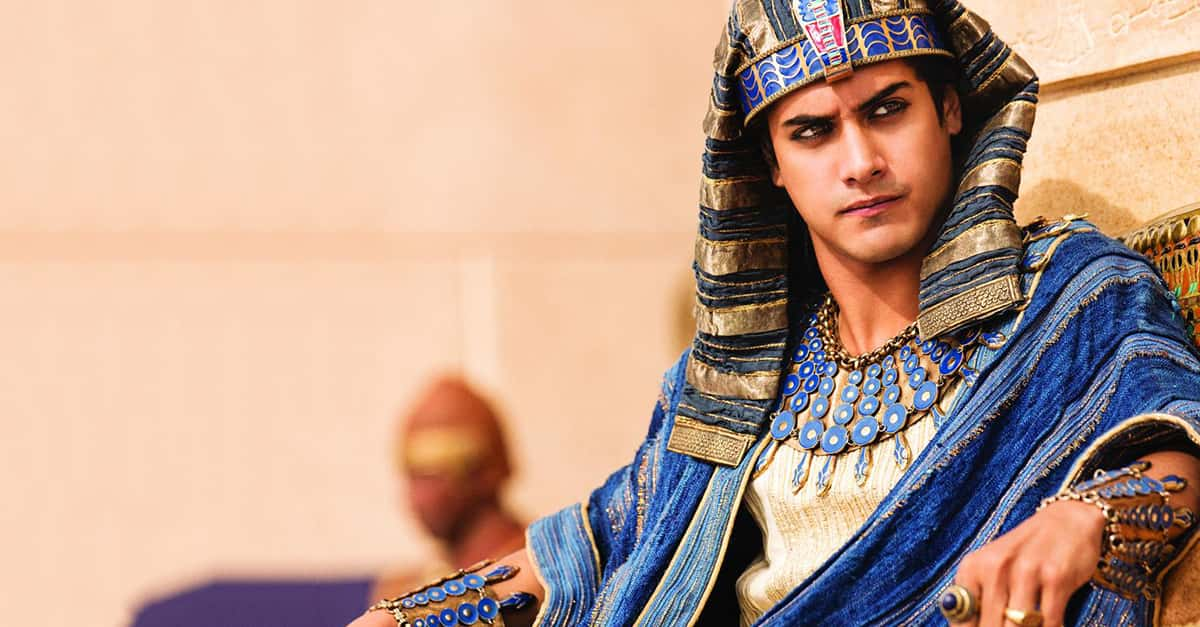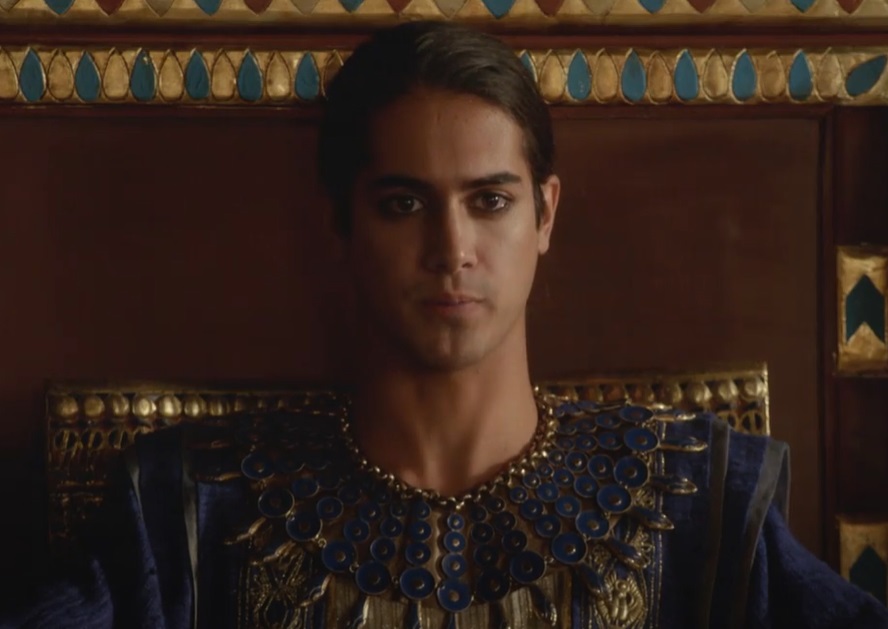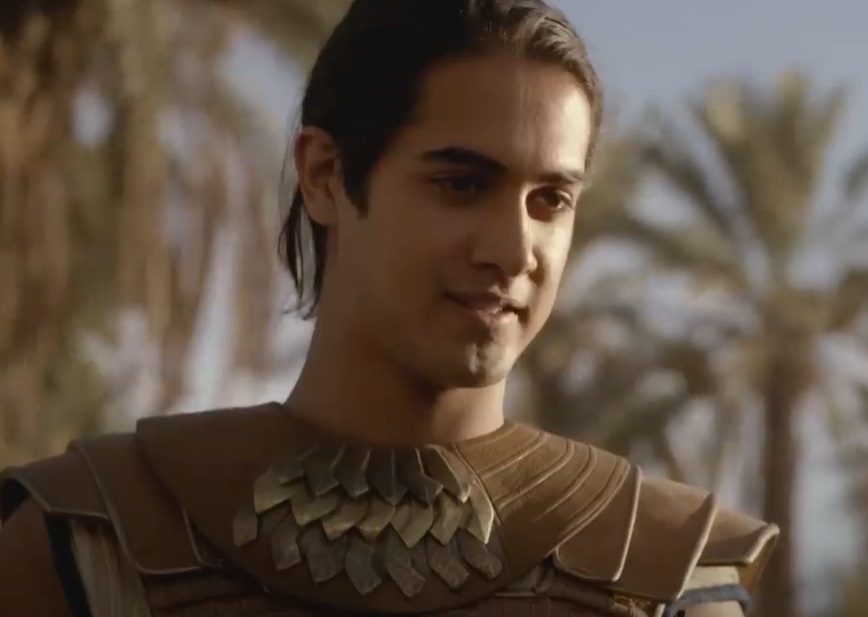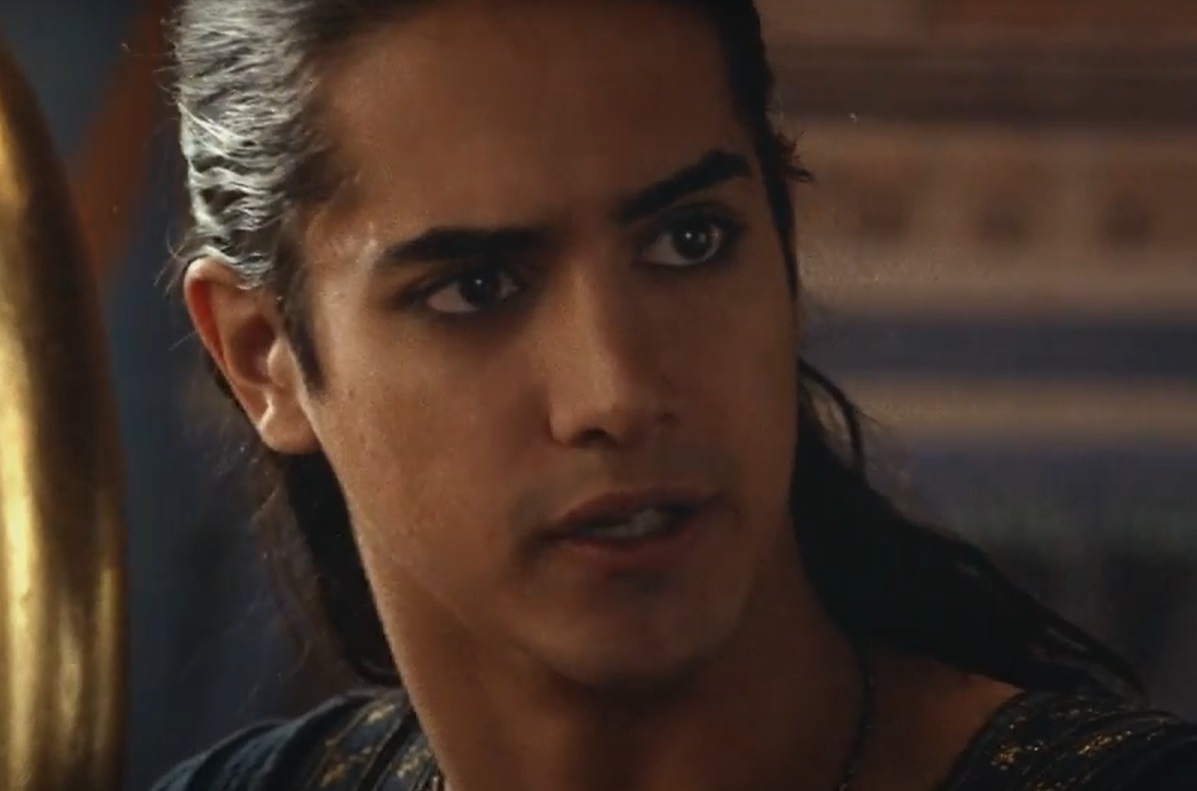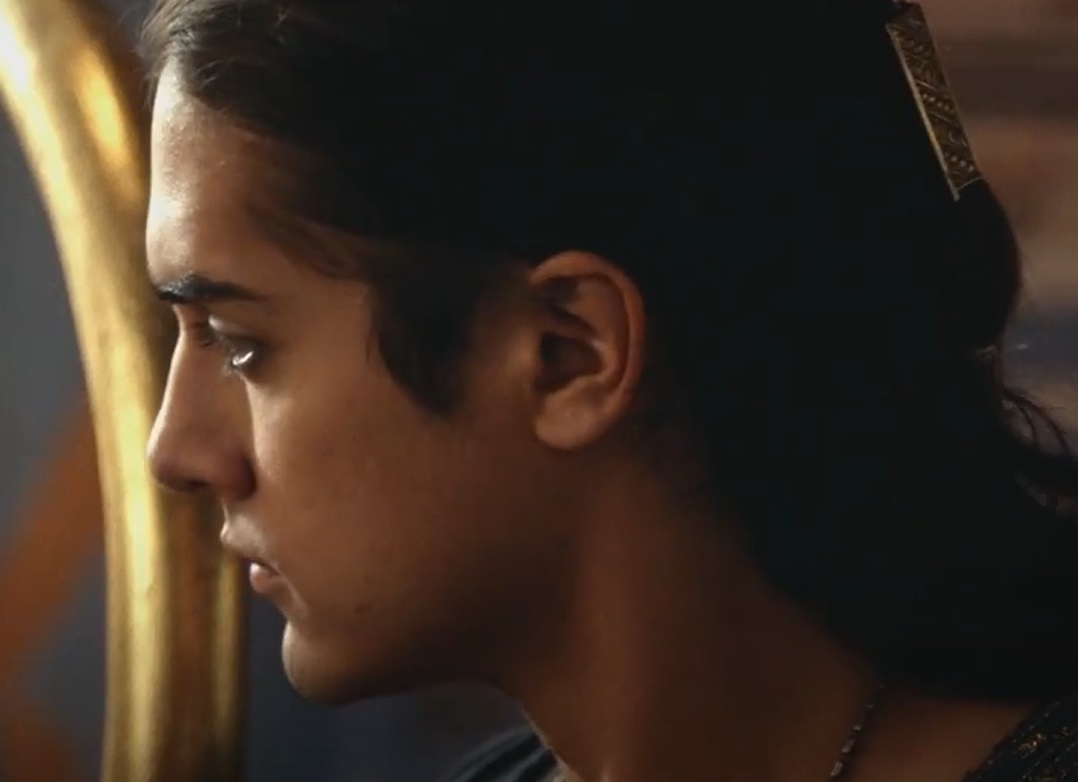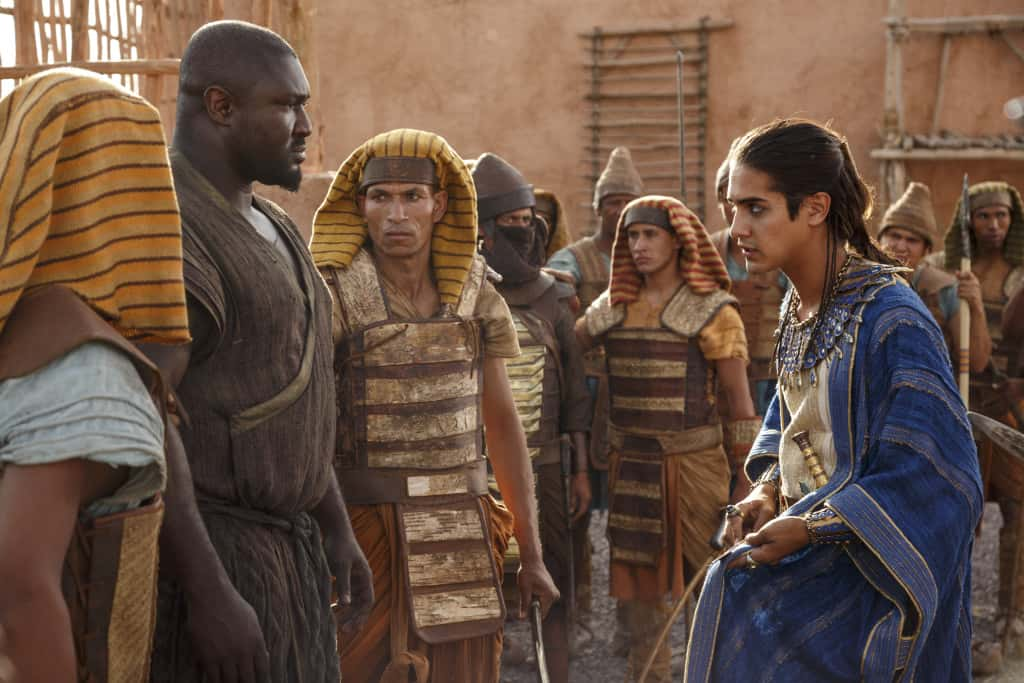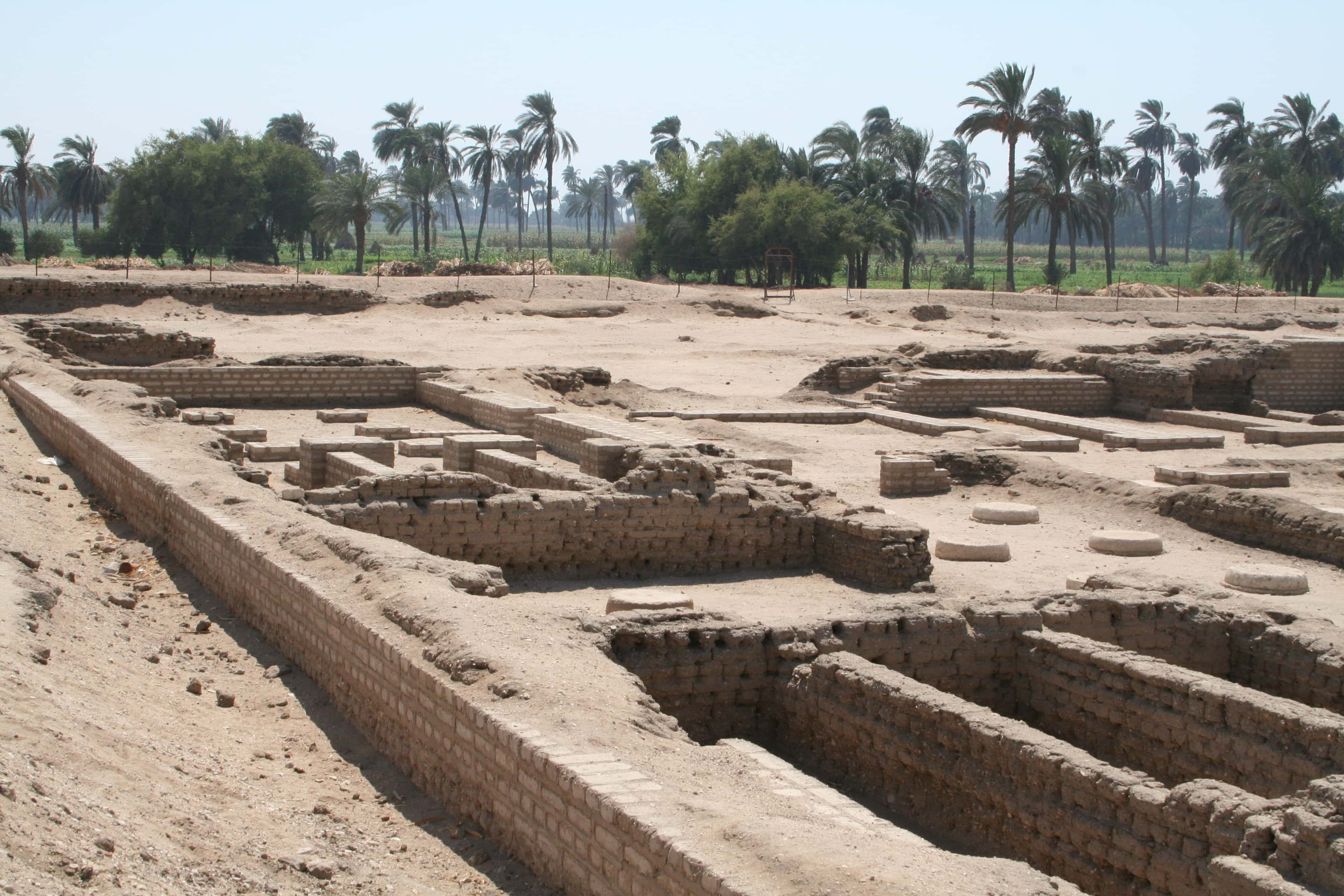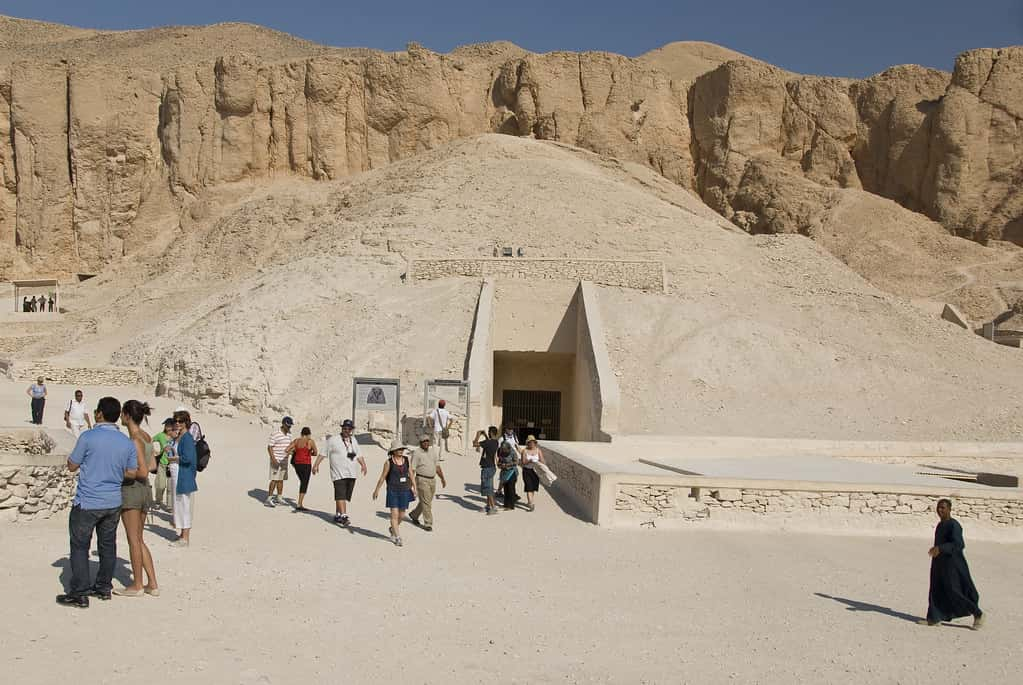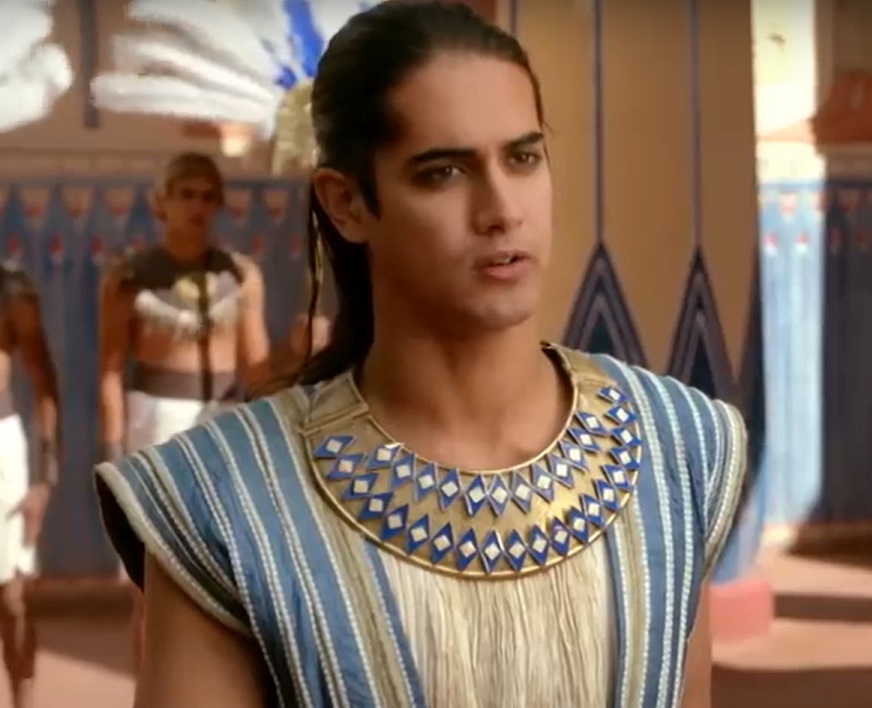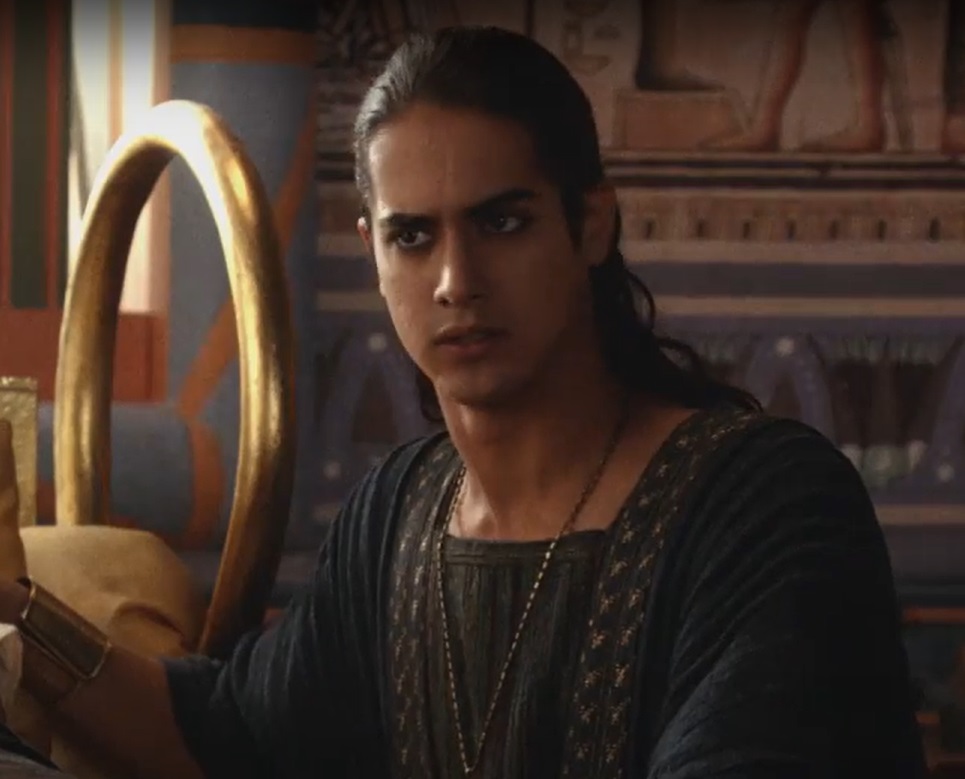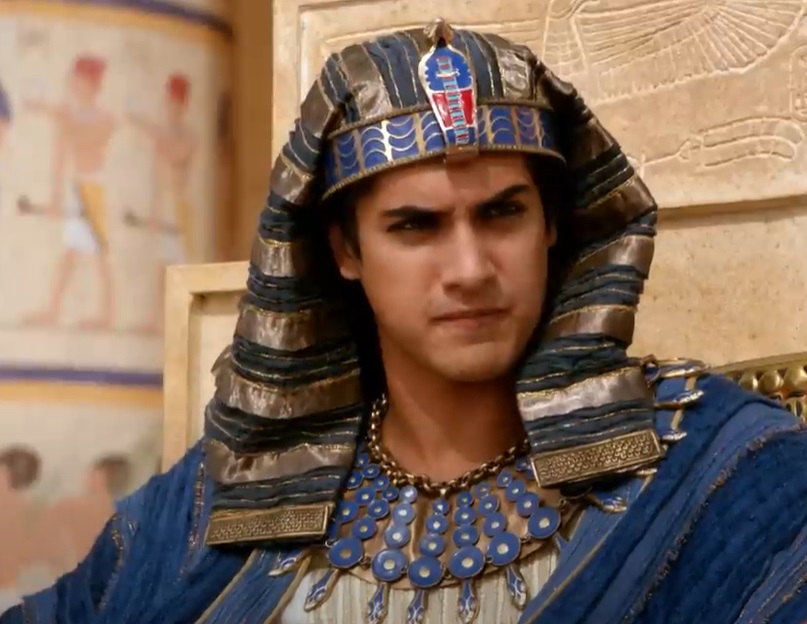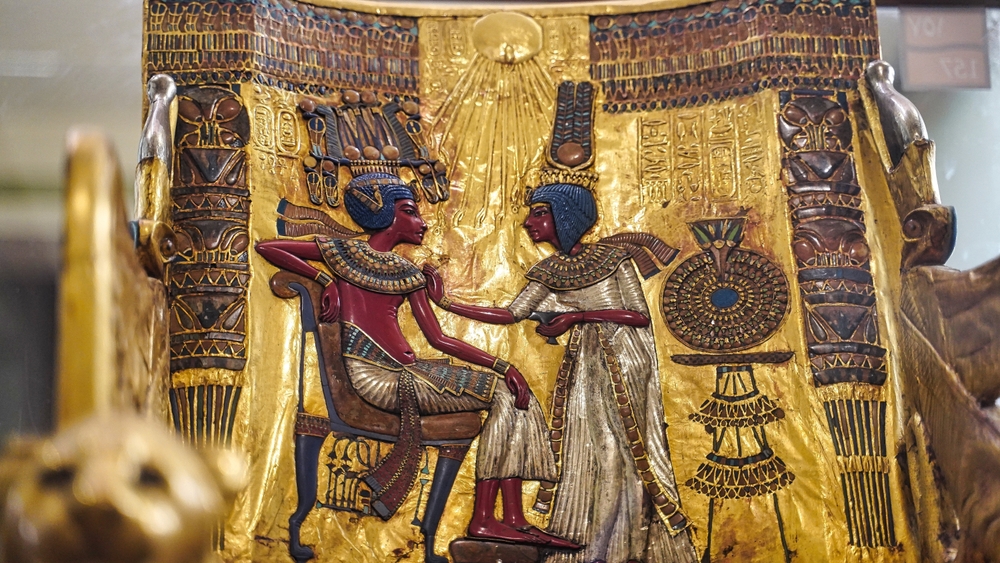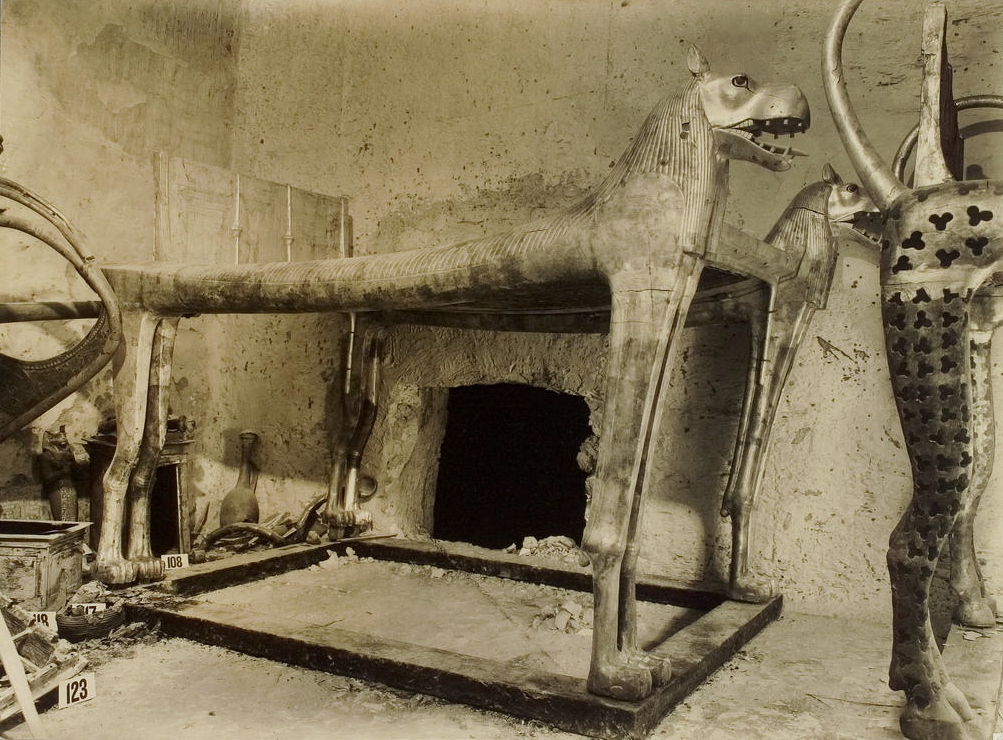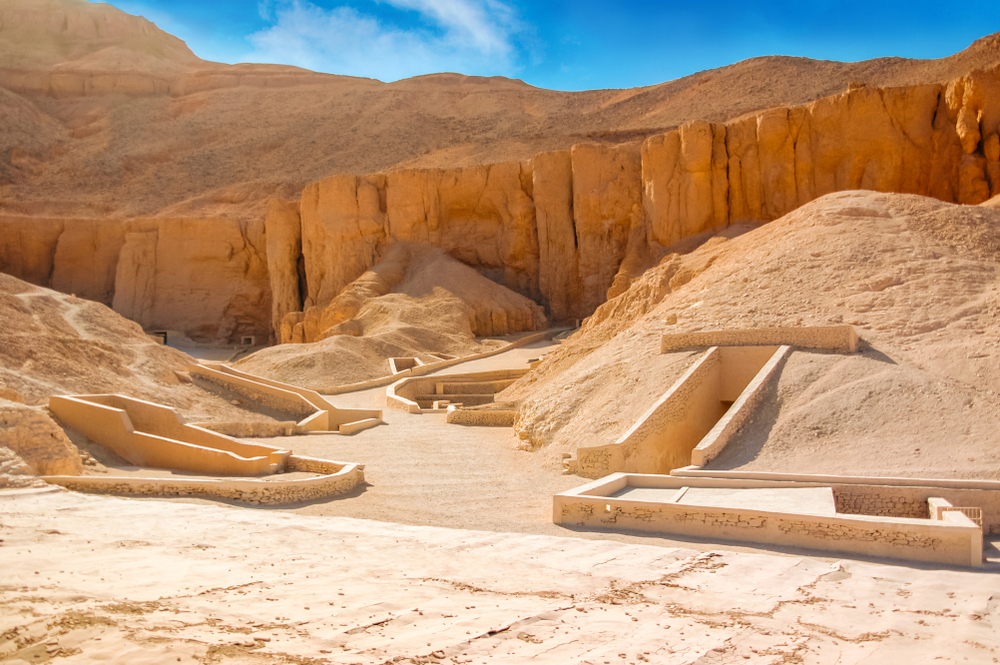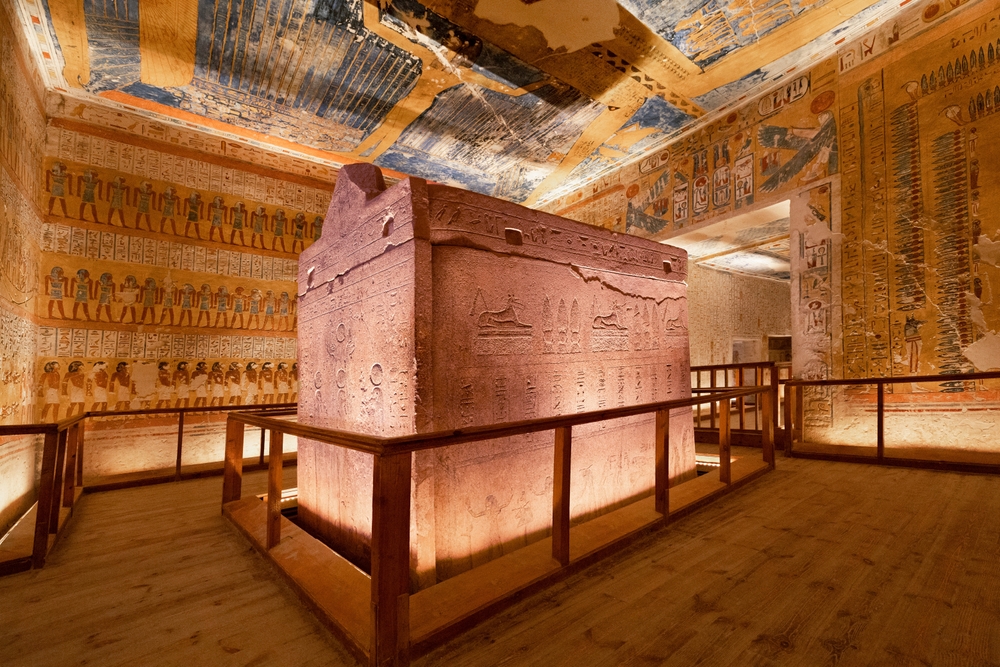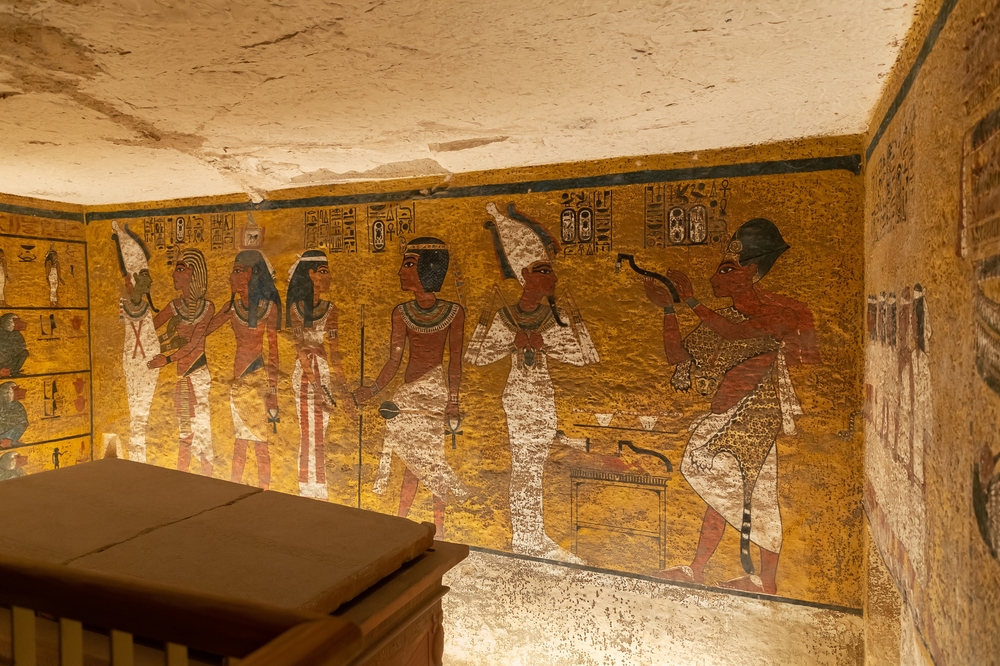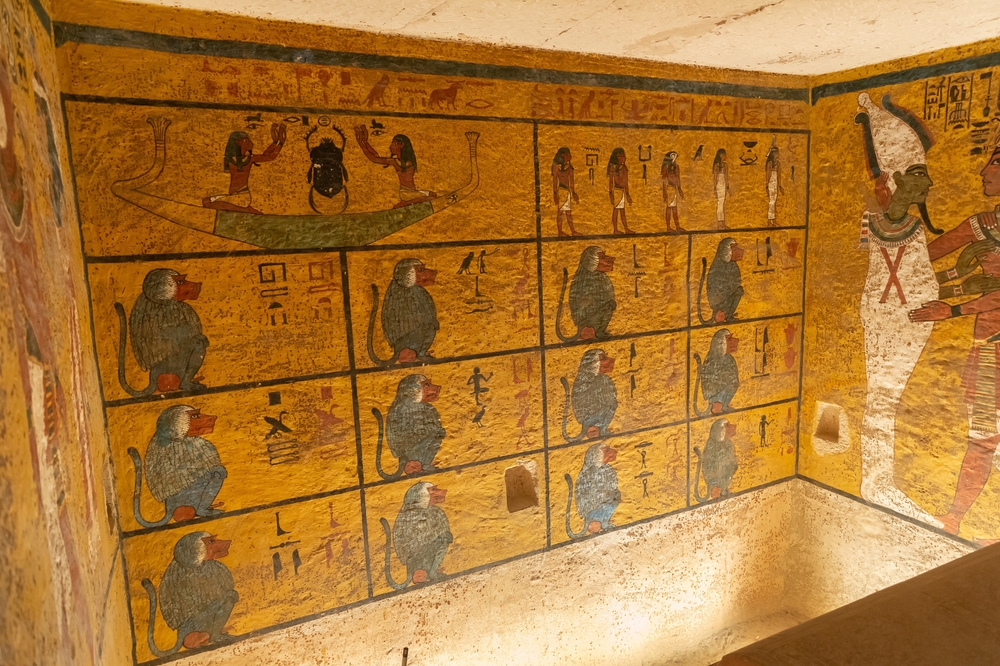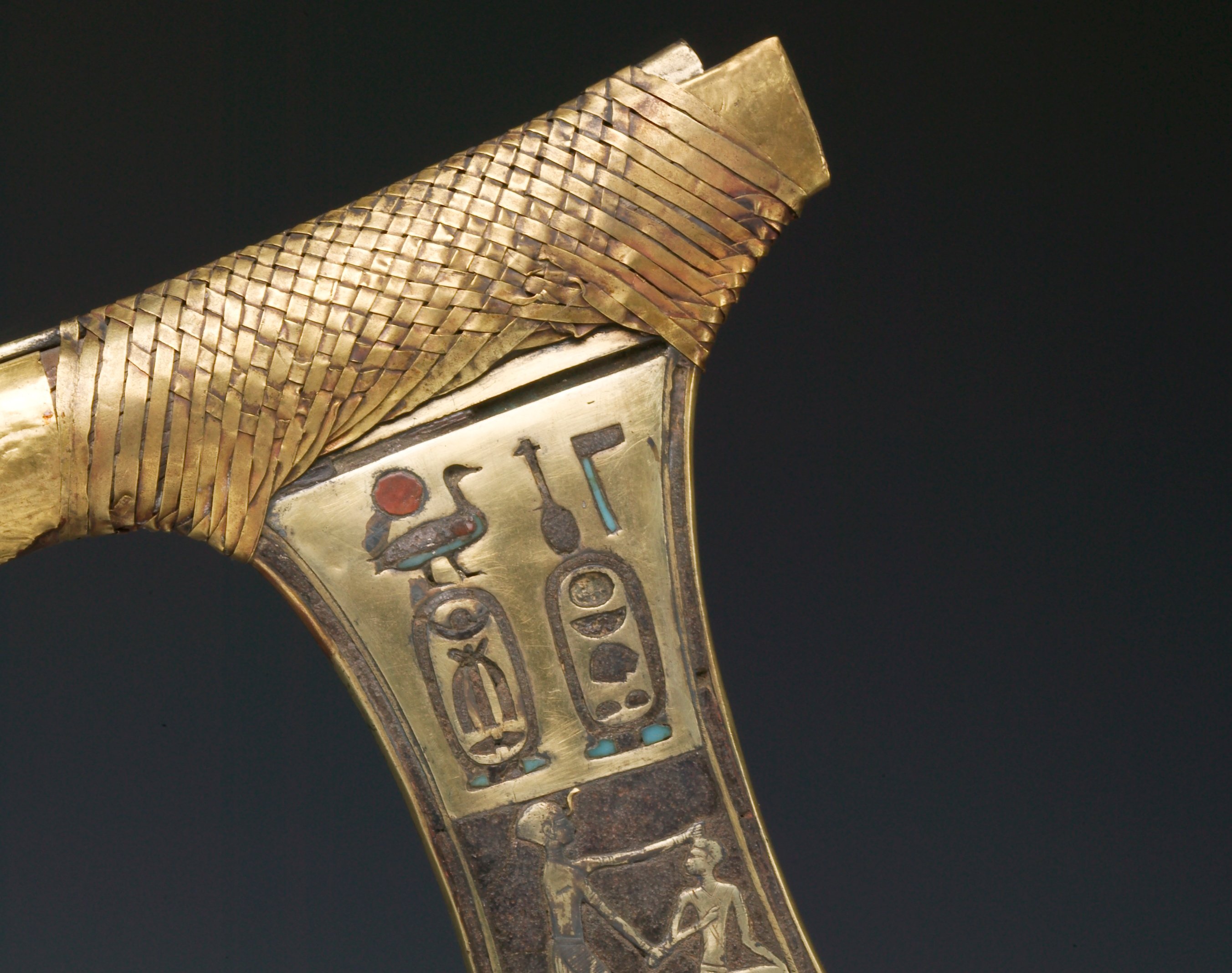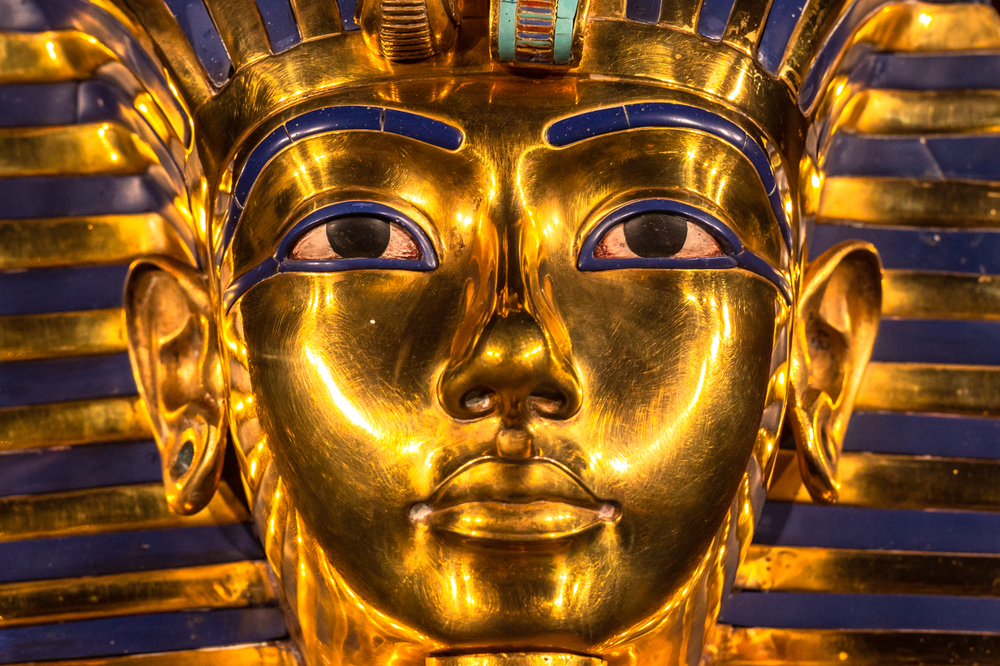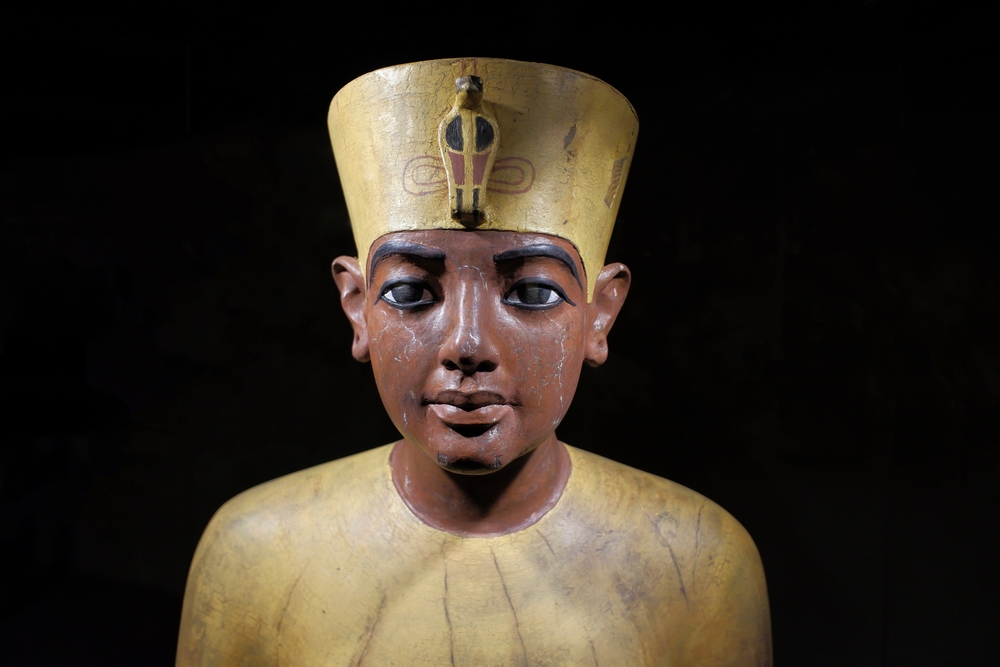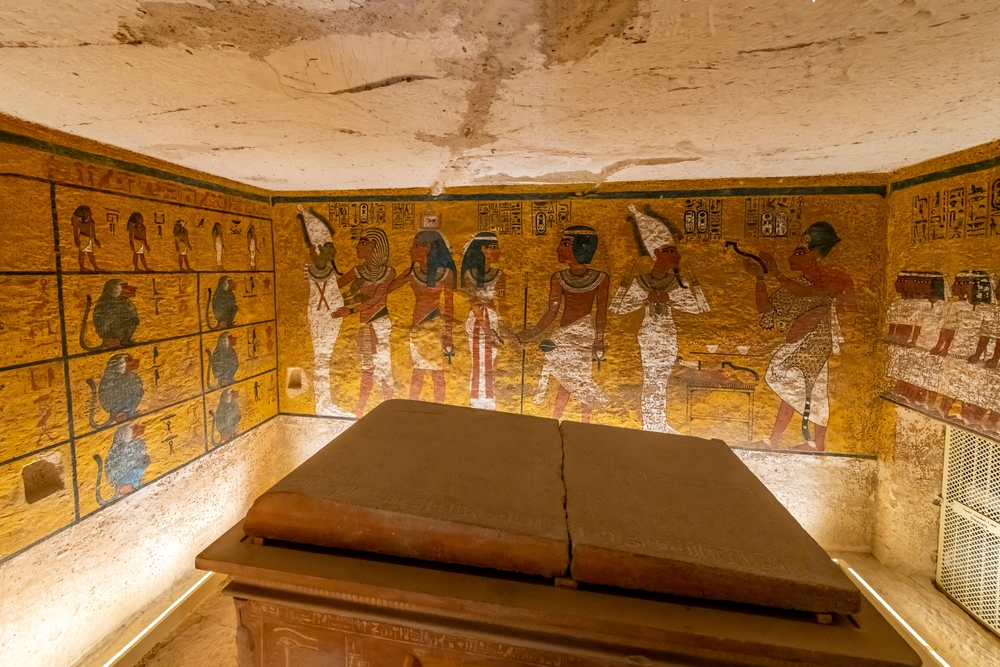King Tut’s brief reign in the over 3,000 years ago left little mark on history—until the discovery of his pristine tomb in the 1920s led to an explosion of interest in the ancient and monumental Egyptian civilization. But despite his shining legacy, Tutankhamun's broken remains, exquisitely preserved, reveal the truth about his life was less than golden.
1. He Took After His Parents
Pharaoh Tutankhamun was born circa 1341 BCE during the chaotic reign of the Pharaoh Akhenaten, in Ancient Egypt's Eighteenth Dynasty. His father is widely-accepted to be Akhenaten himself, an iconoclast whose reign was so controversial and sacrilegious that later Pharaohs tried to erase from history completely.
His mother, however, is more of a mystery.
2. His Mother’s Identity Is Mysterious
DNA testing has named the mummy known as “The Younger Lady” as King Tut’s mother, though her name is lost to time. Her mummy was found in a secondary tomb near Akhenaten's resting place, known as tomb KV35.
At some point in her history, the Younger Lady mummy suffered extensive damage, likely caused by ancient tomb robbers. But how did they identify her? Well, it wasn't as hard as you would think...
 Tut, 2015, Muse Entertainment Enterprises
Tut, 2015, Muse Entertainment Enterprises
3. His Parents Kept It In The Family
The same DNA testing that identified King Tut’s parents also revealed that his parents were full siblings. This kind of inner-family marriage was not uncommon among royal families of the era (and, indeed, in royal families worldwide for many subsequent centuries).
But King Tut’s father didn’t stick around long enough to form much of a bond with his son.
4. He Became Pharaoh Young Age
King Tut ascended to the throne at around nine years old, following the successive passings of his father and his two short-reigning successors. He might have been young, but he was still the king—and like any king, he needed a queen by his side.

History's most fascinating stories and darkest secrets, delivered to your inbox daily.
5. He Kept It In The Family Too
Following in the tradition of his family, King Tut married his half-sister, Ankhesenamun, sired by his father with another woman. Disturbingly, historians believe she married her own father before his passing (again, a custom that was not uncommon in ancient Egypt).
Perhaps this close couple was cursed, because their attempts at parenthood became marred by tragedy. Muse Entertainment Enterprises, Tut (2015)
Muse Entertainment Enterprises, Tut (2015)
6. His Kids Didn’t Make It
King Tut eventually fathered two daughters, whose bodies were buried with him in his tomb. Tragically, neither of the King’s children survived very long—the bodies discovered with him were those of tiny babies. Historians believe one daughter did not live long after birth. The other child’s story is more gut wrenching still.
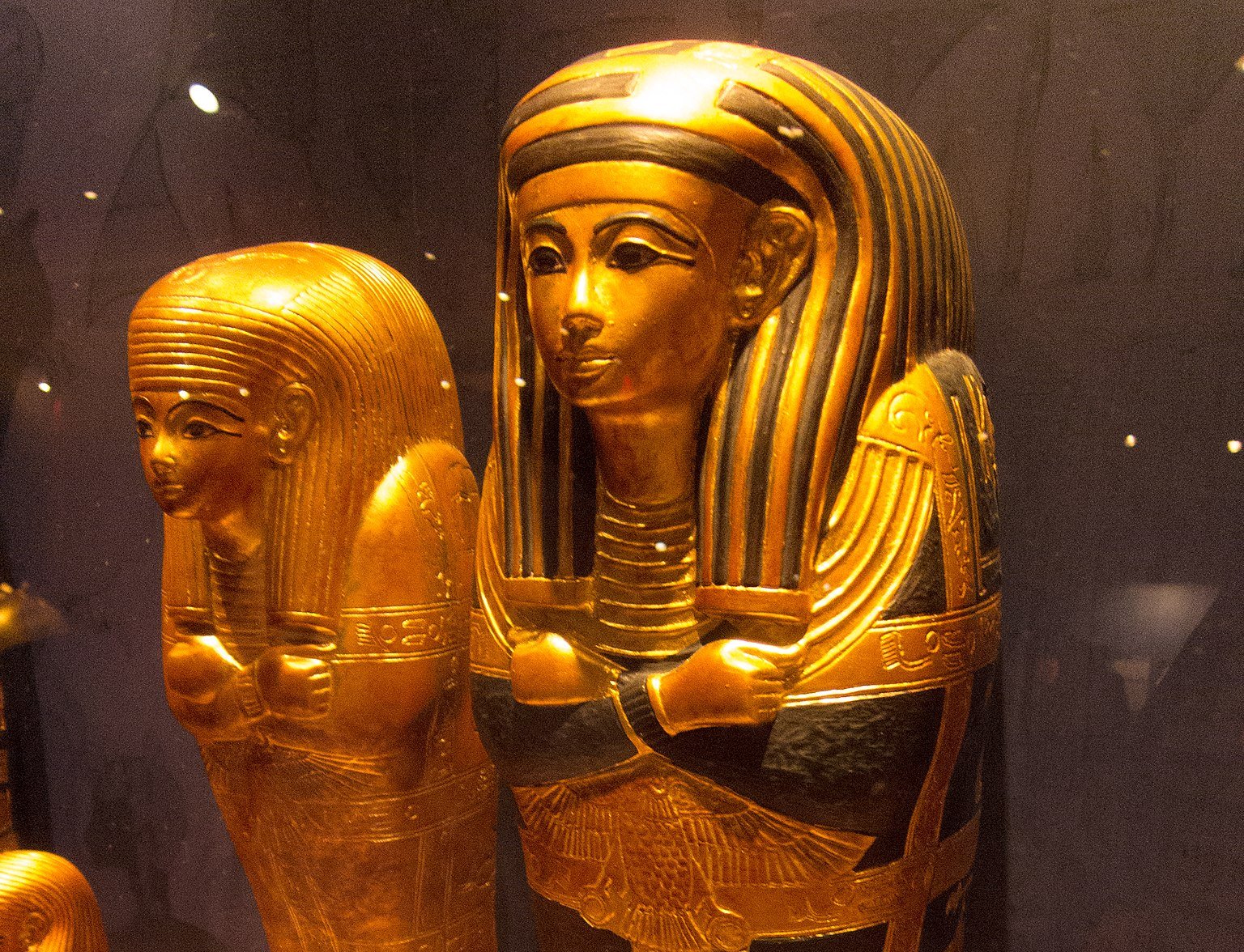 Thomas Quine, CC BY 2.0, Wikimedia Commons
Thomas Quine, CC BY 2.0, Wikimedia Commons
7. His Tomb Revealed Early Tragedy
The mummified remains of King Tut’s daughters were very small, one significantly so. Scientists concluded that one of the royal daughters was born prematurely, likely after only five to six months of pregnancy. A premature baby in this time had little to no hope of survival.
His daughters’ burial with him seems to reveal a touching soft side to this ancient King's personality. There have been discoveries made about his physical appearance too.
8. He Probably Had A Winning Smile
King Tut was a (quite literal) short king, thought to have stood at about 5 ft 6 in tall, with a narrow waist and rounded hips. The discovery of his skull also revealed one shocking characteristic very uncommon to the era: He had great teeth. He had an overbite characteristic of his bloodline, but his pearly whites were in excellent condition, nonetheless.
But that wasn't King Tut's only notable facial feature.
9. He Had An Interesting Face
CT scans of Tutankhamun's mummy also revealed something about him that had never been seen in any artistic depictions: He was likely born with a partial cleft palate. The fact that he never allowed this detail to be included in images of himself indicates he felt some shame about it.
But ailments were just one of King Tut's problems. He also had to deal with the mess his father left behind.
10. He Reigned In A Difficult Era
King Tut ascended to the throne during a turbulent era known as the Amarna Period. His father Akhenaten had completely upended the kingdom by outlawing the thousand-year-old Ancient Egyptian religion and instituting his own monotheistic religion called Atenism.
Akhenaten's religious reforms started to deteriorate the moment he was gone, and by the time King Tut took the throne, the situation had descended into chaos. It was too much for the young pharaoh to take on alone.
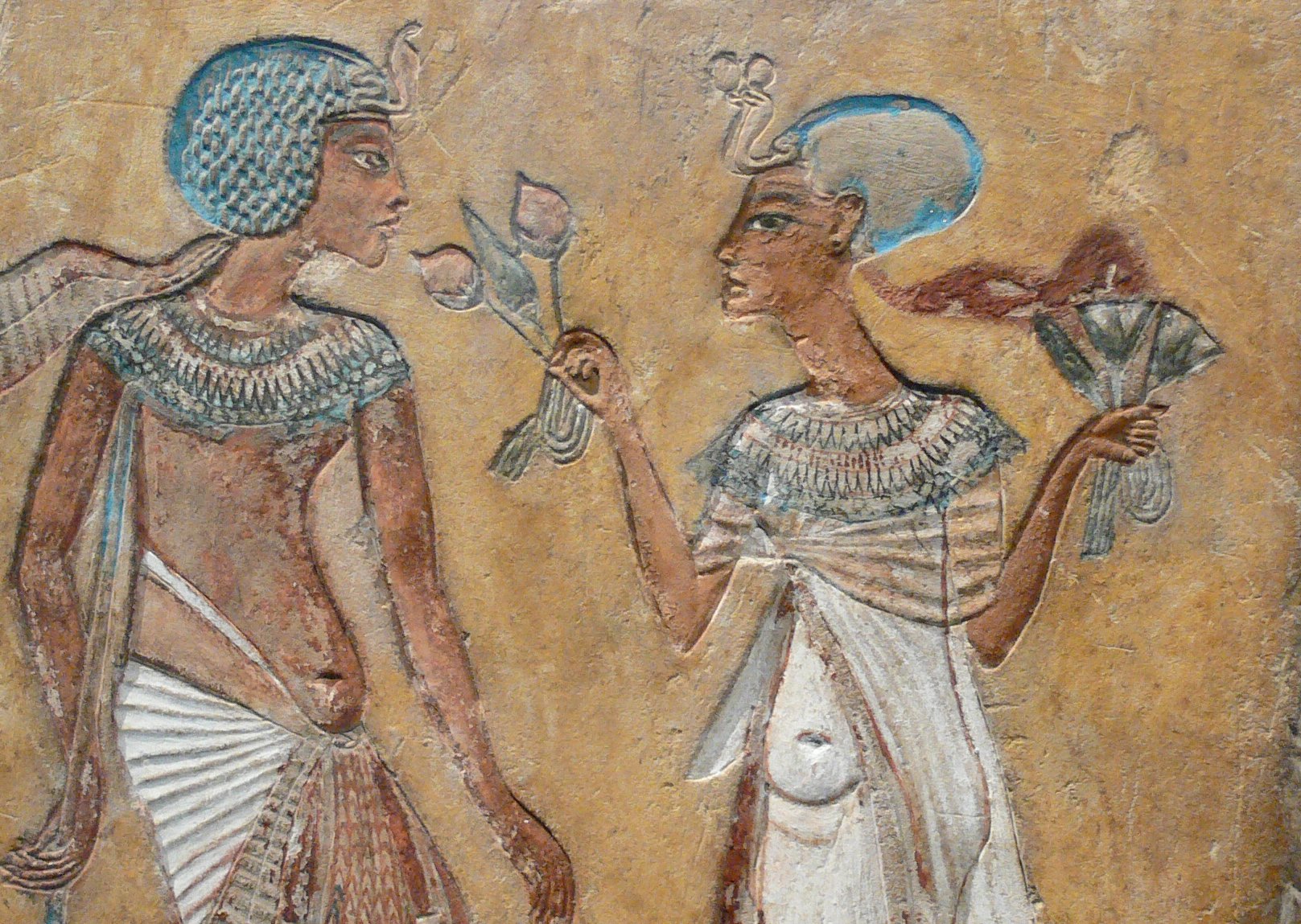 Andreas Praefcke, Wikimedia Commons
Andreas Praefcke, Wikimedia Commons

History's most fascinating stories and darkest secrets, delivered to your inbox daily.
11. His Court Hosted A Power Struggle
Due to his young age, it's likely that King Tut’s advisors enacted most of his political agenda, at least for the first few years of his reign. Many of these courtly figures had their own ambitions and ideas of what to do with the empire. Some of them came from humble origins.
12. He Promoted From Below
One of King Tut’s closest advisors was the man he appointed Lord of the Land: his general, Horemheb. Notably, unlike most of his peers, Horemheb was of peasant birth and had worked his way up the ranks of the military to attain his honored position in the pharaoh’s court.
But Horemheb's responsibilities were a little more hands on than most...
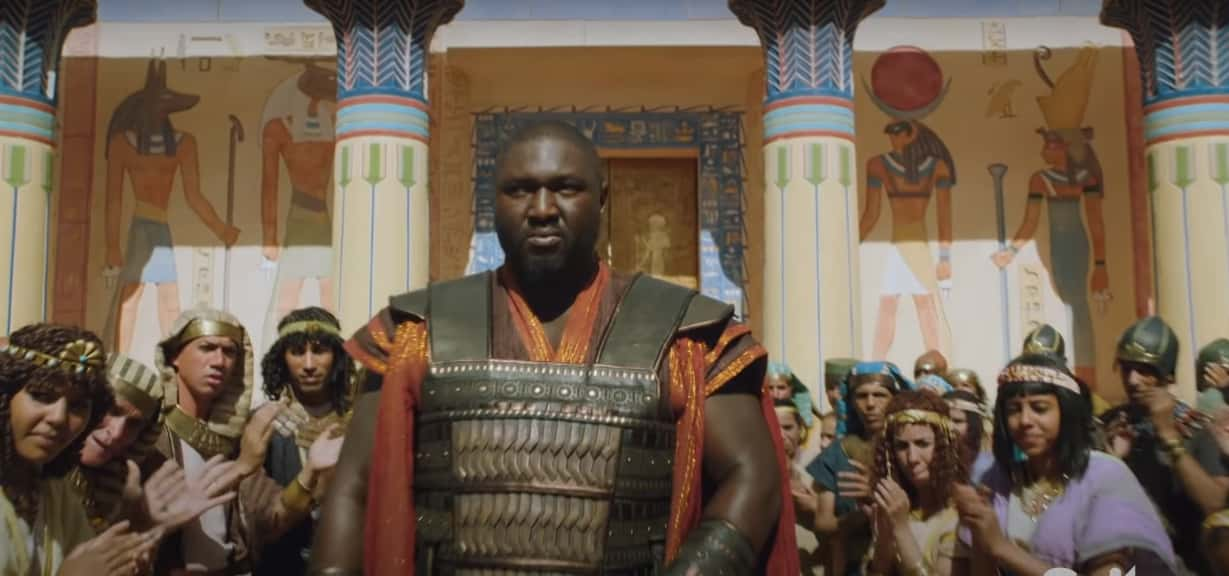 Muse Entertainment Enterprises, Tut (2015)
Muse Entertainment Enterprises, Tut (2015)
13. He Had Some Childish Traits
King Tut had appointed Horemheb to his position to maintain law and order, but the pharaoh needed some soothing himself. The young King was known for his childish temper tantrums when he did not get his way, and his general possessed a unique skill: The ability to calm his young liege when these tantrums flared.
But there was one insidious idea King Tut's advisors wanted to put in his head more than anything else...
14. He Reversed His Father’s Policies
Many in the kingdom still disapproved of Akhenaten's move away from traditional Egyptian religion, and the young King’s advisors shared this view. Under their direction, King Tut began to restore the polytheistic Egyptian religion and undo his father’s religious shift to Atenism. This entailed a grand reconstruction.
15. He Restored The Faith
King Tut—or, most likely, his advisors—undertook several large rebuilding projects, restoring temples and monuments across the kingdom. Tut also reinstated traditional cults and returned priests to their former positions of power. But that wasn't enough. He needed to do something much more drastic.
16. He Made A Big Move
King Tut’s father had also moved the location of the royal court from Memphis (near modern-day Cairo) to the city of Amarna, a symbolic rejection of the old ways. Though it was the capital when he was born, Tutankhamun moved the court back to Memphis, and left Amarna to gather dust. The city limped along for a few years before being abandoned entirely.
But while King Tut abandoned Akhenaten's city, he did not reject his father entirely.

History's most fascinating stories and darkest secrets, delivered to your inbox daily.
17. He Relocated His Father
Despite bending to the will of his advisors and moving his capital back to Memphis, King Tut nonetheless appeared hesitant to abandon his father entirely. Evidence appears to suggest that he exhumed the former pharaoh’s body from near Amarna and reburied it in the esteemed Valley of the Kings.
But even if he had a soft spot for his old dad, King Tut nevertheless continued working to undo everything Akhenaten had done.
18. He Was Responsible For Some Iconic Images
Among the many building projects King Tut initiated, perhaps one of the most well-known is the avenue of sphinxes leading to the temple of Mut. The King endowed existing statues with elaborate new ram heads and accompanying statues of his likeness.
Yet even more than the structures he built, the monuments to the young man himself reflected an even larger religious shift.
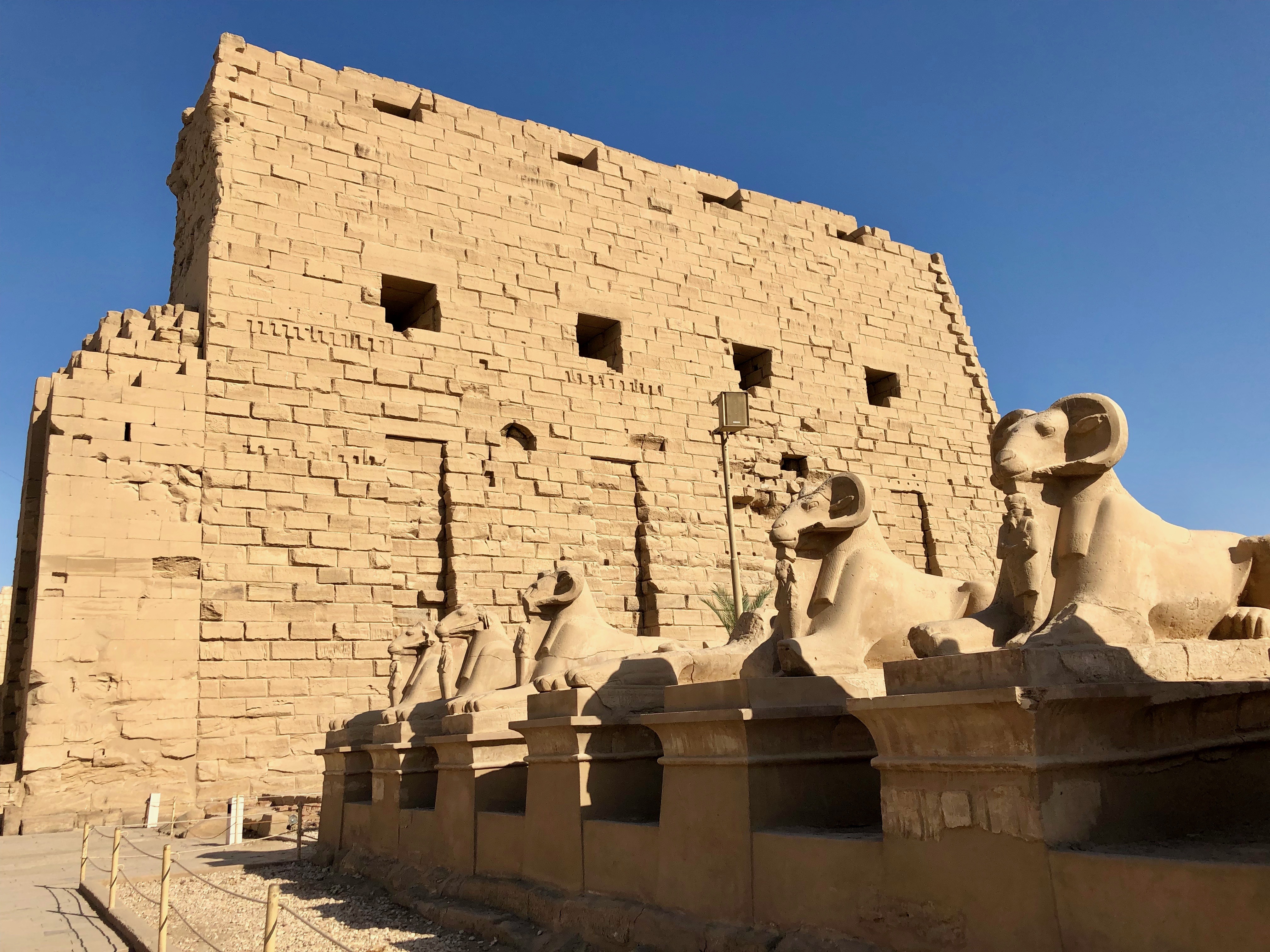 Warren LeMay from Chicago, IL, United States on Wikimedia
Warren LeMay from Chicago, IL, United States on Wikimedia
19. They Worshipped Him As A God
While Ancient Egyptians typically deified pharaohs after they passed, King Tut was special. Though his reign didn't last long, he became one of the few pharaohs to be deified and worshipped as a god while he was still alive. This was likely due to his efforts in restoring the traditional religion and his favor among the priesthood.
This deification allowed him certain supernatural powers.
20. He Bestowed His Favor
Evidence suggests King Tut’s cult of worship gained near-universality throughout Ancient Egypt. People would come from across the land to appeal to this demigod for his forgiveness for their sins, and for his favor to cure them of their ailments. And the pharaoh’s benevolence stretched beyond his own people.
21. He Was A Diplomat
Egypt found itself in economic turmoil following the reign of King Tut’s father, and it had resulted in diplomatic neglect. The young pharaoh attempted to restore peace with neighboring kingdoms, and the presence of various gifts from other countries in his burial tomb suggests he was successful in these endeavors.
Still, young as he was, King Tut was no pushover.
22. He Had A Perfect Record
There was not a complete absence of conflict during King Tut’s reign, with evidence that the boy pharaoh embarked on at least some military campaigns. Historical evidence suggests that King Tut remains one of the few undefeated kings of Egypt, perhaps suggesting a penchant for martial strategy.
His prowess in battle, however, is another matter entirely.

History's most fascinating stories and darkest secrets, delivered to your inbox daily.
23. His Participation Is Unclear
It is the subject of some debate whether King Tut ever actively participated in battle, and there is no historical consensus agreed among historians. Evidence for his presence on the battlefield includes the impressive armoury found in his tomb, as well as imagery depicting the young pharaoh in battle.
Though this may have been figurative—and there's definitely some proof that Tutankhamun might have had some serious disadvantages in combat.
24. He May Have Been Disabled
The strongest evidence against King Tut’s battle prowess is the historical speculation that he may have had significant physical disabilities. Evidence from DNA testing has suggested that he may have suffered from bone necrosis and clubfoot, and the presence of an ornate cane in his burial tomb heavily implies he may have relied on it for mobility.
Sadly, the young King’s poor health caught up with him eventually.
25. He Perished Young
King Tut’s reign ended prematurely only nine years after his ascension to power. The King passed at the tragically young age of 18 after presiding over an enormously transformative time in power. So, how did it happen? Well, the cause of his demise has sparked fierce debate.
26. He Succumbed To Illness
As there are no surviving records of the circumstances of King Tut’s passing, many theories have arisen. The most likely cause is a combination of factors, mainly a fractured leg evident from his remains, and complications from severe malaria infection.
In fact, genetic testing has revealed that the latter seems to have been a bane on the King’s existence.
27. He Had A Lot Of Malaria
Tests on King Tut’s remains revealed several infections of the most severe strain of malaria, likely leading to significant health difficulties for the young pharaoh. In fact, the parasites found in King Tut’s remains are the oldest known genetic proof of malaria, making the King part of medical history too.
But the boy king's frailty didn't end there.
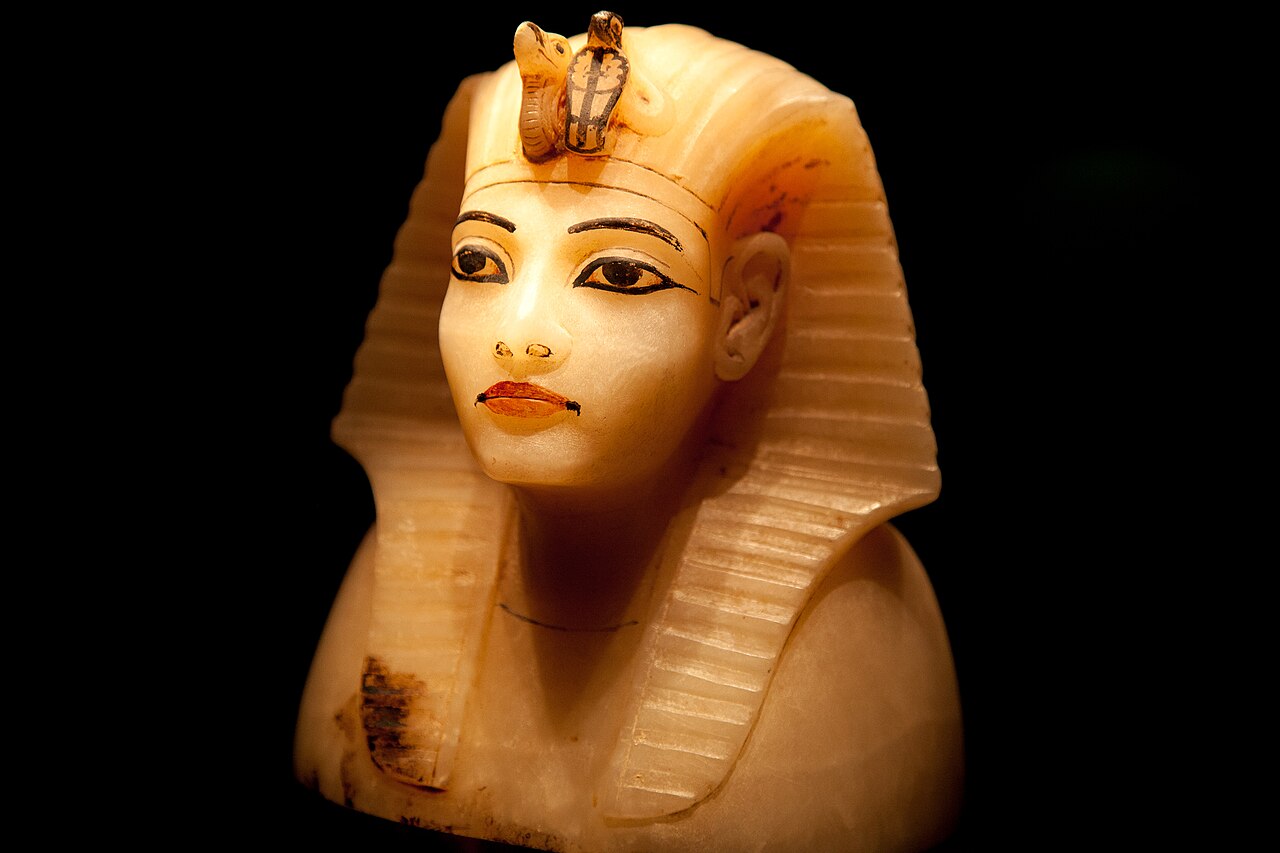 Dave Nakayama, CC BY 2.0, Wikimedia Commons
Dave Nakayama, CC BY 2.0, Wikimedia Commons
28. He Was A Sickly Boy
King Tut’s depiction in ancient art and the mysterious circumstances around his youthful passing have led many scientists to theorize that he suffered from many different ailments. Based on varying degrees of evidence, some of those posited include bone necrosis, clubfoot, scoliosis, gynecomastia, various intellectual disabilities, and epilepsy.
Regardless of the cause, the sudden demise of the young pharaoh sparked other problems.
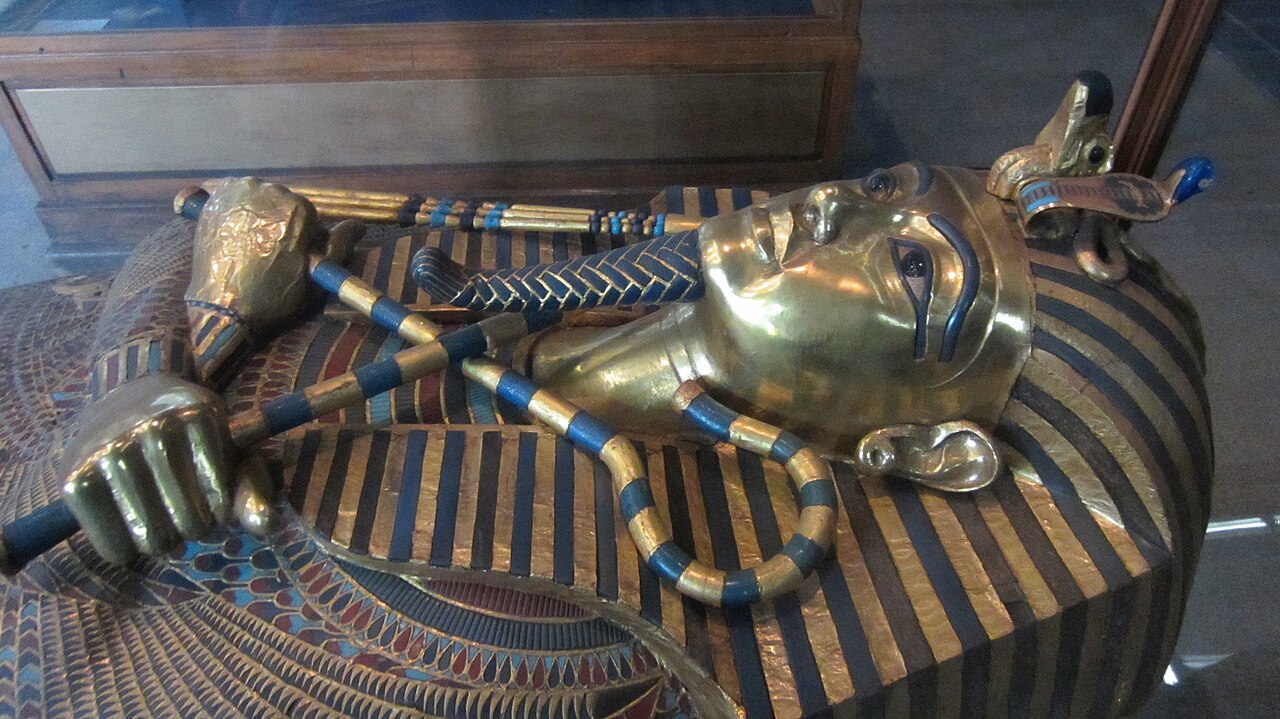 A. Parrot, CC BY-SA 4.0, Wikimedia Commons
A. Parrot, CC BY-SA 4.0, Wikimedia Commons

History's most fascinating stories and darkest secrets, delivered to your inbox daily.
29. His Family Weren’t Ready
King Tut’s early departure from this world was clearly unexpected. It appears the royal tomb intended for his eventual burial was incomplete at the time of his passing. As it was Egyptian custom to observe bodies for precisely 70 days between demise and burial, the court likely had no choice but to choose an unusually small tomb when the time came.
But to be honest, that was the least of their problems. All of King Tut's work returning the kingdom to stability was already falling apart.
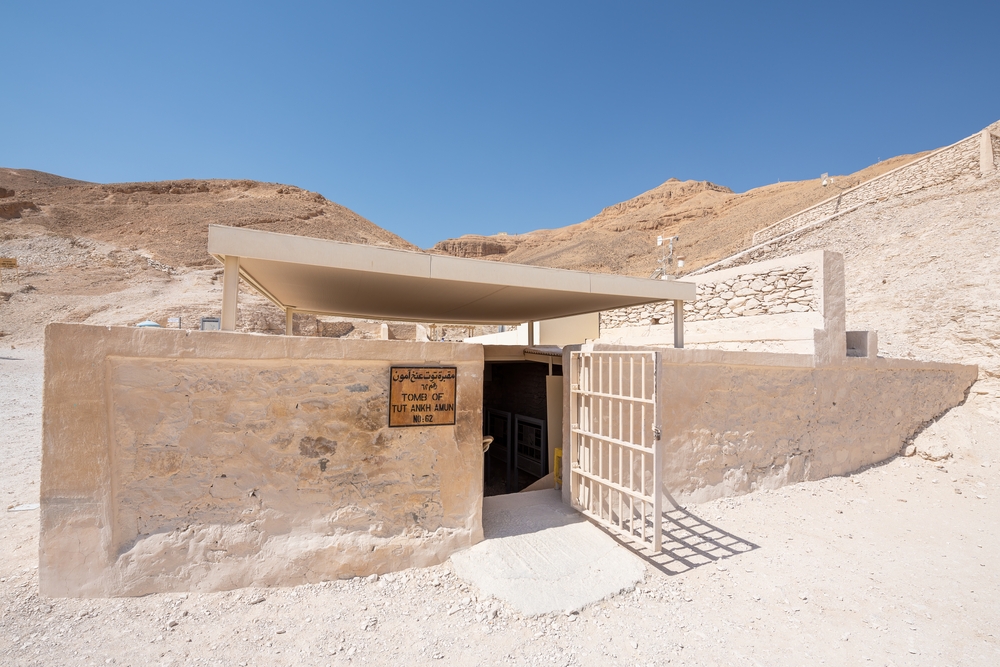 Nick Brundle Photography, Shutterstock
Nick Brundle Photography, Shutterstock
30. He Was The Last Of His Dynasty
As King Tut had not fathered any surviving daughters, let alone sons that could carry on the patrilineal tradition, his passing marked the end of his bloodline. This succession crisis threw the kingdom into immediate instability once again—and there were several different people who had their eyes on the throne.
31. His Wife Maintained Her Stature
As per Egyptian custom, King Tut’s wife Ankhesenamun was to marry the new ascendant King following her husband’s passing. Horemheb moved to take power, but there was one thing he didn't consider: Ankhesenamun did not desire to marry a man of peasant birth like him.
This left an opportunity open for another of King Tut's advisors.
32. His Advisor Won The Day
Amid the succession crisis, it appears King Tut’s vizier Ay maneuvered his way into the coveted position of pharaoh, as he at least had some royal blood. Unfortunately, no details of Ay’s plot survived, but we know he was successful because art from the era depicts him presiding over King Tut’s funeral, a customary duty for the successor pharaoh.
But he didn't get to enjoy the fruits of his labor for long.
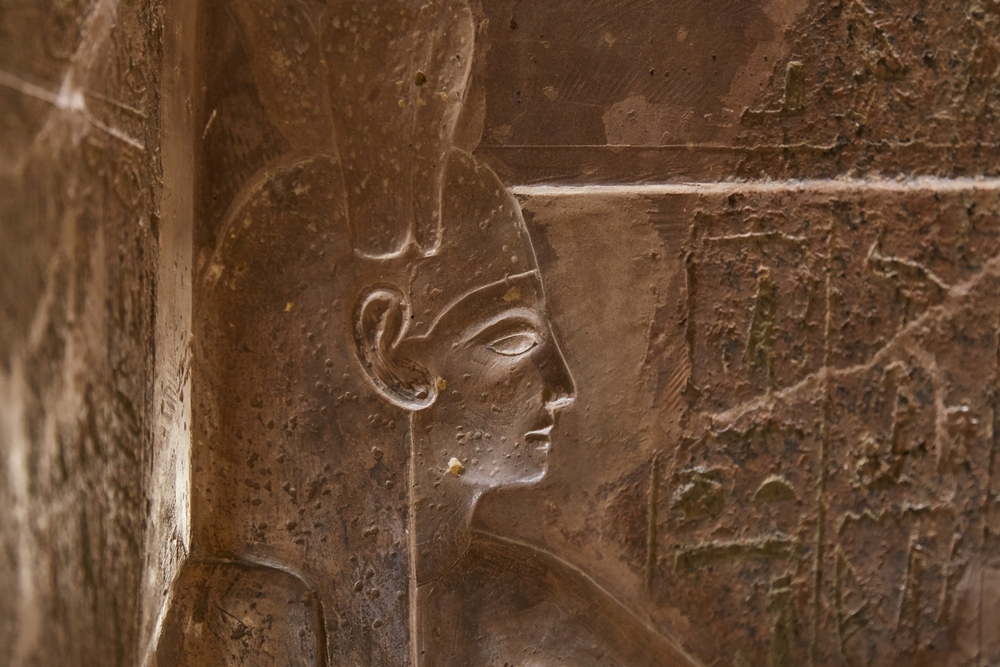 Sailingstone Travel, Shutterstock
Sailingstone Travel, Shutterstock
33. His General Got There In The End
Ay was an elderly man when he assumed King Tut’s throne, and his reign was short-lived. He passed not long after taking power and, again, before siring an heir with Ankhesenamun. Ay had tried to name his own son, Nakhtmin as heir, but it appears his son perished before having a chance to assume the throne too.
Historical records indicate that Horemheb finally got his wish, and he succeeded Ay as the next pharaoh after some struggle. But the struggle appears to have left him bitter.
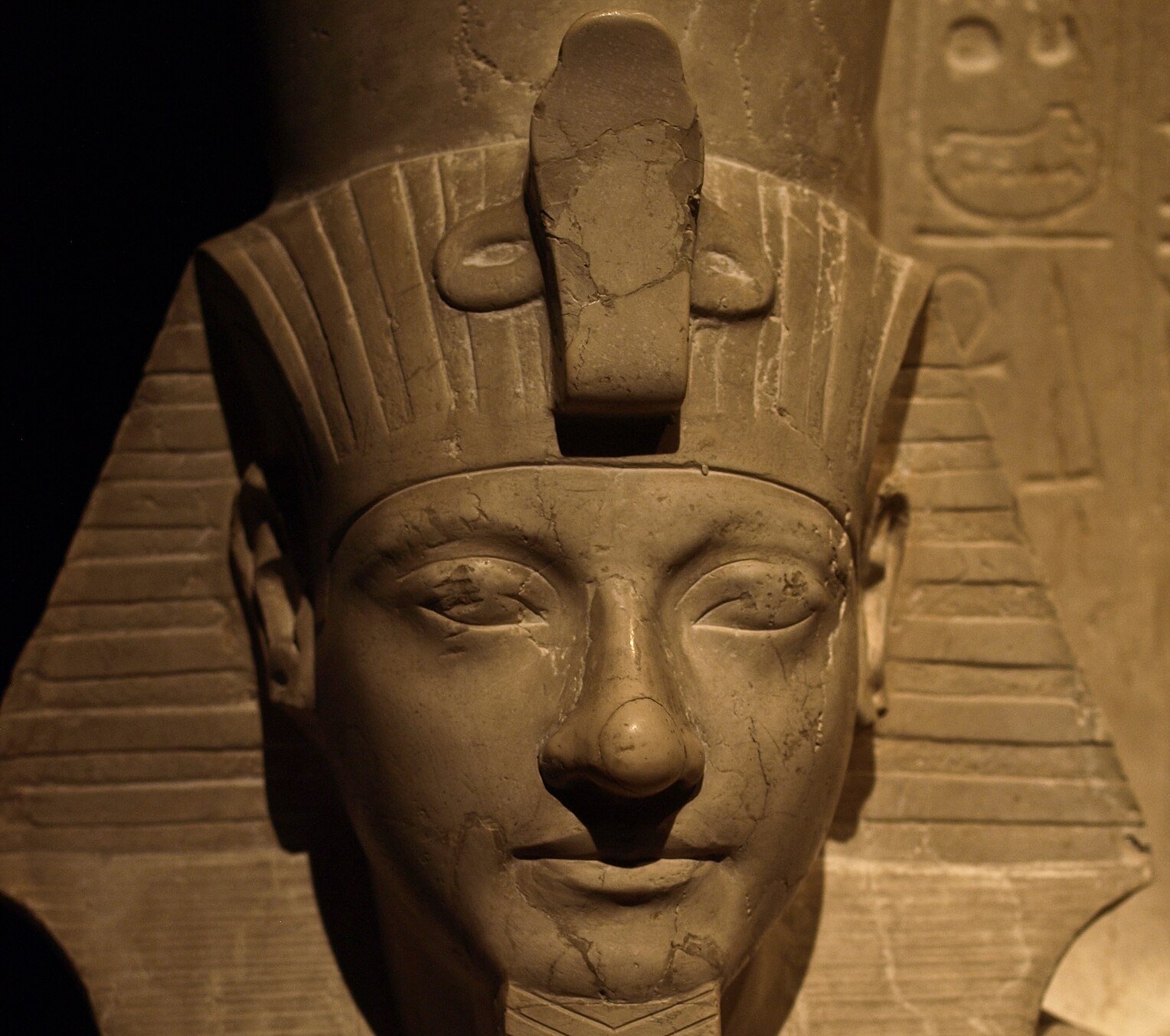 Captmondo, CC BY-SA 3.0, Wikimedia Commons
Captmondo, CC BY-SA 3.0, Wikimedia Commons
34. His Legacy Got Usurped
Horemheb appears to have felt scorned by his initial dismissal in the succession process. He began to usurp many of the monuments built in King Tut’s honor, replacing depictions of the younger pharaoh with ones of himself.
Perhaps there was some respect left for his former liege, however: Horemheb bitterly defaced Ay’s tomb, but left King Tut’s untouched, indicating some acknowledgement of the close relationship he had with the boy. And history thanks him for it.
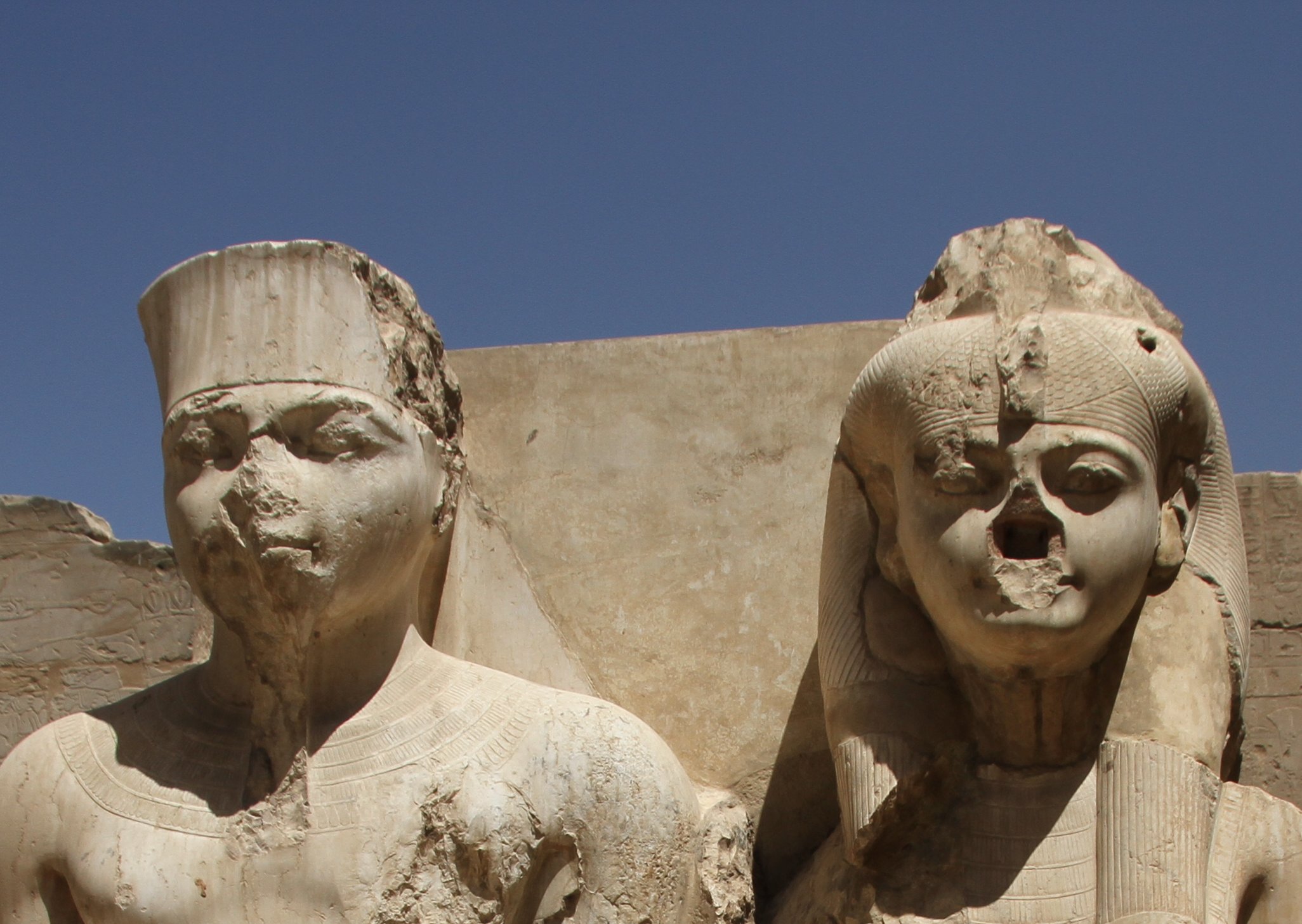 Roadwarrior Photography, Shutterstock
Roadwarrior Photography, Shutterstock

History's most fascinating stories and darkest secrets, delivered to your inbox daily.
35. His Tomb Was Lost…
King Tut’s final resting place remained relatively untouched for millennia after his burial. It was eventually buried by debris from subsequent tombs built over it, and further obscured with the construction of workers’ houses over the entrance. Unlike the tombs of most Egyptian pharaohs, King Tut's would not be rediscovered by anyone for 3,000 years.
36. …And Then Found
In 1922, archaeologist Howard Carter got an invitation to excavate the Valley of Kings by colonial landowners. His large crew set to work systematically uncovering tomb after tomb, and on November 4, they discovered one that was different than any of the rest.
Varying accounts attribute the discovery to either workmen digging beneath the workers’ huts or to a local young boy digging outside the designated work area. Regardless, what they found was awe-inspiring.
37. His Tomb Was Spotless
Most of the tombs Carter’s team had uncovered up until this point were in varying states of damage and disrepair. However, through a sheer ancient stroke of luck, they found King Tut’s tomb in a near-perfect state of preservation. The pharaoh’s remains reflected his surroundings.
38. He Was In Good Condition
King Tut’s body, like his tomb, was relatively undisturbed. It would prove to be a wellspring of historical and scientific discovery. Notably, the pharaoh was missing a heart, which the Egyptians believed was crucial for resurrection. Historians have posited that the removal of King Tut’s heart was likely a reference to the story of Osiris; pharaohs were said to be an incarnation of the god himself.
That wasn't the only way they referenced Osiris, but the other way was, ahem, a little below the belt.
39. They Discovered Him At Full Mast
Archaeologists found King Tut’s body with his, uh, member mummified in an erect, 90-degree position. Historians believed this was another reference to the god Osiris, the erection seen as a literal evocation of Osiris’ regenerative powers. But while the King was whole in some ways, he was lacking in others.
40. Someone Tampered With His Body
Other than his heart, which King Tut was likely buried without, the only missing part of his body was a section of his chest. Specifically, the wall of the chest and several ribs were missing. Archaeologists have concluded that this was likely the result of an early plunder of the tomb, not long after the pharaoh’s burial, where the robbers stole a beaded collar.
But lucky for us, the intruders looked past plenty of other things that they could’ve taken.
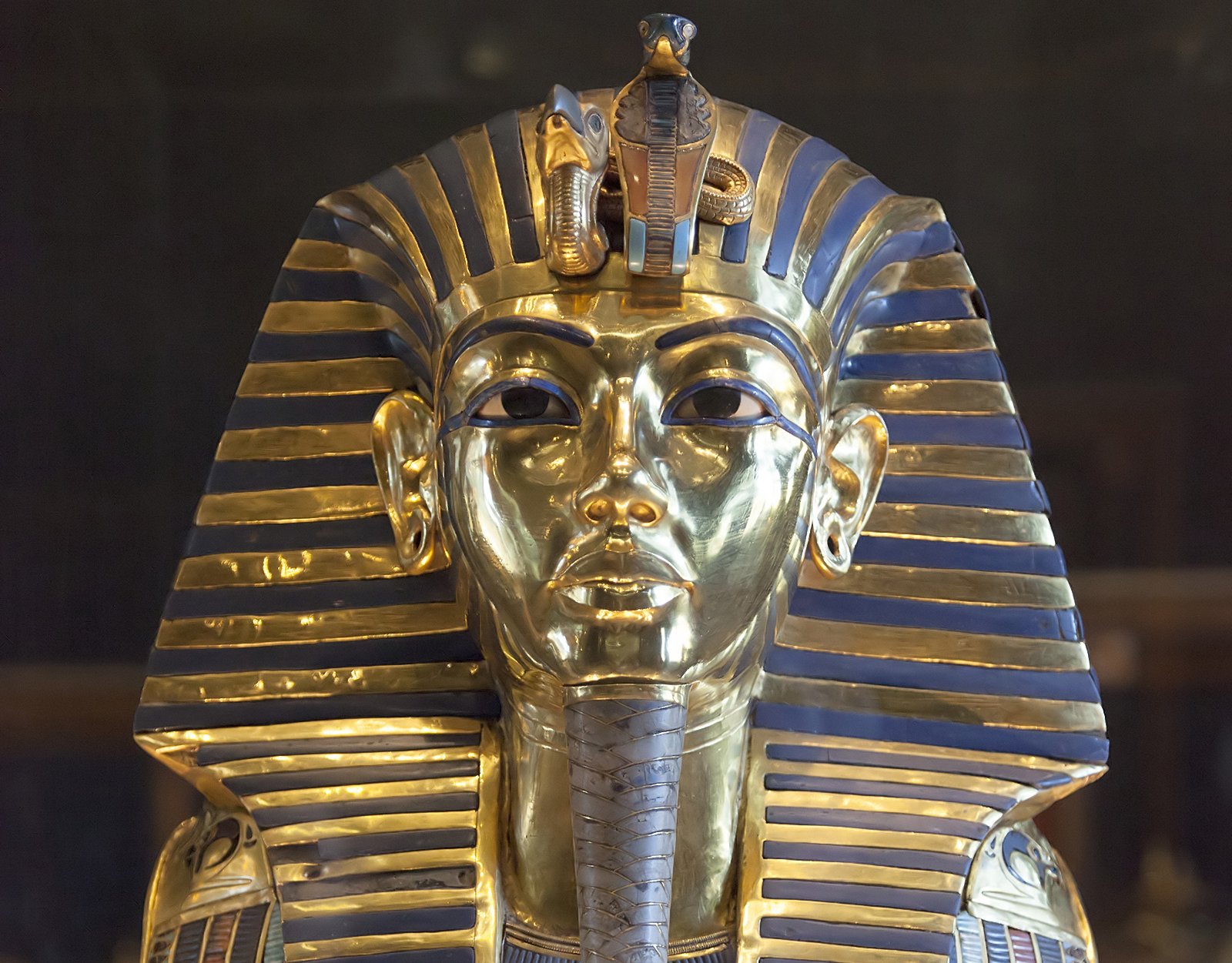 Roland Unger, CC BY-SA 3.0, Wikimedia Commons
Roland Unger, CC BY-SA 3.0, Wikimedia Commons

History's most fascinating stories and darkest secrets, delivered to your inbox daily.
41. His Tomb Was Rife With Treasure
Buried alongside King Tut was a trove artifacts that remained in near-pristine condition even millennia later. Among the 5,398 objects found in his tomb, archaeologists uncovered a coffin, a face mask, thrones, musical instruments, chalices, furniture, food, wine, sandals, and, most importantly, fresh underwear.
Many weapons were discovered as well, including one particularly interesting blade.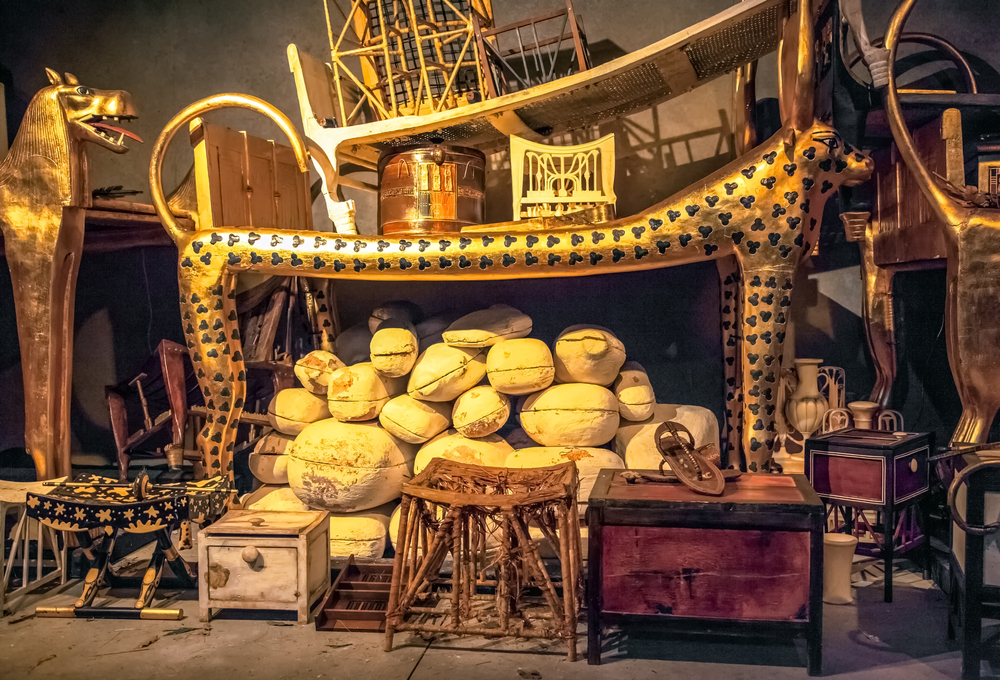 Jaroslav Moravcik, Shutterstock
Jaroslav Moravcik, Shutterstock
42. He Possessed An Otherwordly Blade
Some weapons recovered from King Tut’s tomb included bows and several blades. The significance of one eerily sharp dagger was only recently discovered.
When scientists tested the metal, they determined that it came from a meteorite—but it's highly unlikely that the ancient Egyptians would have the technology to craft a weapon from meteorite debris. So, the dagger either came from a more advanced civilization or, as some are convinced, it could have been left behind by aliens.
43. His Face Became Symbolic
The most recognizable item recovered from King Tut’s tomb was his ornate funerary mask. The depiction, made of gold, turquoise, and other materials, and probably inspired by the pharaoh’s actual face, has become near-synonymous with ancient Egyptian culture.
But contemporary depictions of King Tut have proved somewhat problematic.
44. He Sparked A Controversial Discussion
Since the dawn of the new millennium, technology has allowed several reconstructions of King Tut’s face. Media outlets enthusiastically picked up the depictions. However, one Egyptologist, Stuart Tyson Smith, has criticized these reconstructions as showing a racial bias; most of them depict King Tut as light skinned. Smith opined that “Egyptologists have been strangely reluctant to admit that the ancient Egyptians were rather dark-skinned Africans, especially the farther south one goes”.
Yet many years before, King Tut’s discovery sparked another interesting media frenzy.
45. His Tomb Had A Possible Curse
Fueled by newspaper coverage, rumors have swirled in the years since King Tut’s discovery of a “curse of the pharaohs” unleashed with the discovery of his tomb. The evidence for this is the early demise of several people who have entered the King’s tomb. The story, however, was sensationalized for effect.
Within 12 years of the discovery, 50 of the 58 people who entered the tomb were still alive. Some curse. Still, the rumors were enough to make King Tut a star.
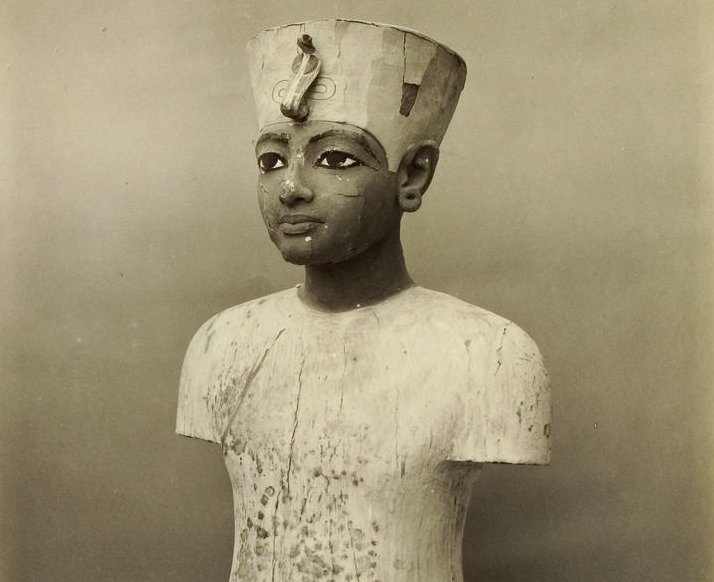 Harry Burton, Wikimedia Commons
Harry Burton, Wikimedia Commons
46. He Made Egypt Great Again
The discovery of King Tut’s tomb made headlines across the world and sparked an explosion of interest in Ancient Egypt; indeed, the now-common moniker “King Tut” was a creation of that very media frenzy. "King Tut" inspired songs, products, and entire businesses—and this was decades before Steve Martin was even born!
In fact, King Tut's influence stretched all the way to the top.

History's most fascinating stories and darkest secrets, delivered to your inbox daily.
47. His Name Made It To The White House
Such was the extent of the “Egypt-mania” of the 1920s that it inspired a Presidential canine. US President Herbert Hoover took office in 1929 and named his dog King Tut. Like everyone else on earth, the discovery of Tutankhamen's treasure trove fascinated Hoover.
It may have been a higher stature than the pharaoh ever reached in life, however.
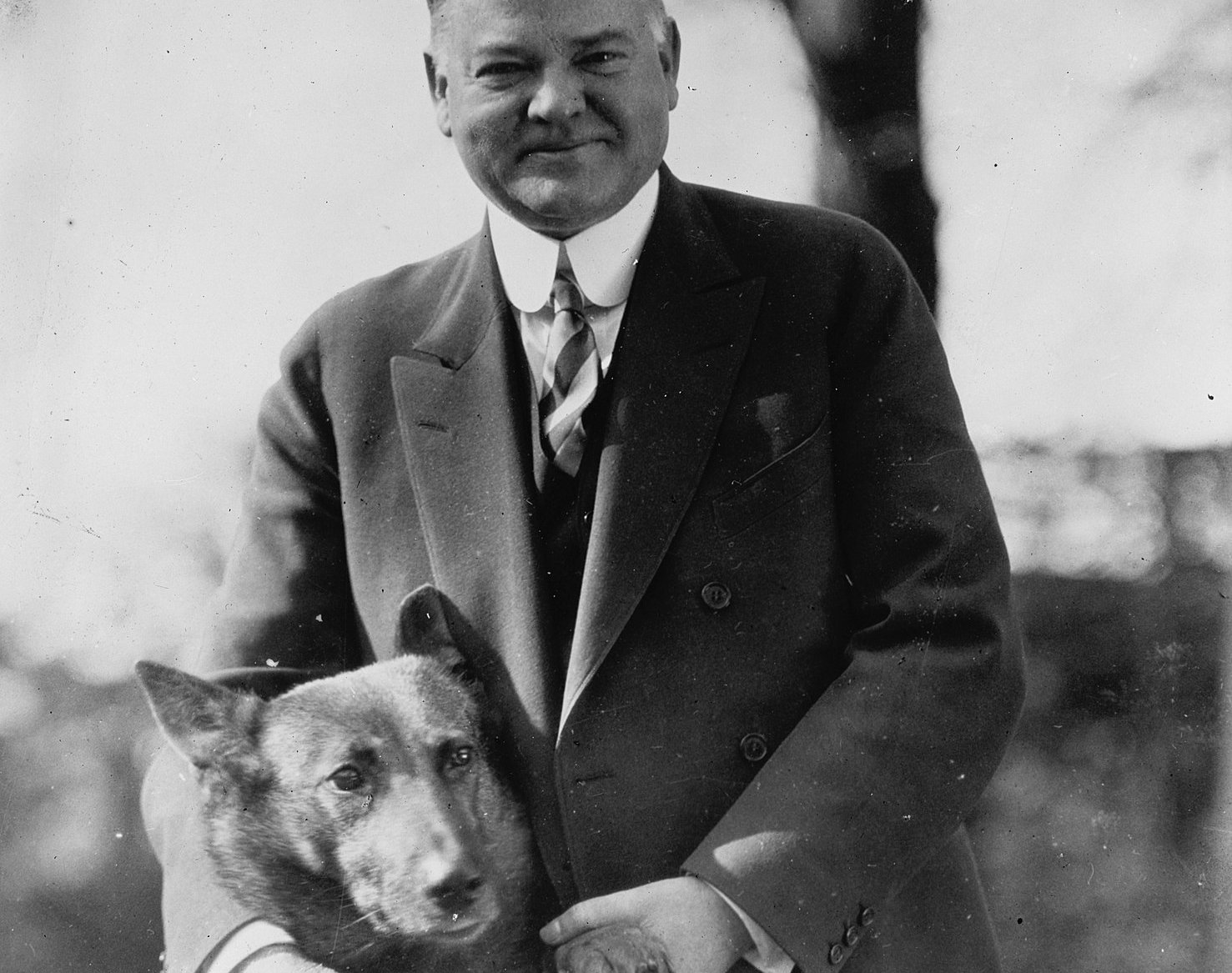 Herbert E. French, Wikimedia Commons
Herbert E. French, Wikimedia Commons
48. His Greatest Fame Was Posthumous
As detailed above, King Tut’s life was tragically short and as a pharaoh, his name made little impact on the culture of his time. However, due to the preservation of his tomb and the publicity of its discovery, he has become more or less the go-to pharaoh in the minds of most people in the modern world.
Partially because King Tut has gone on one heck of a world tour.
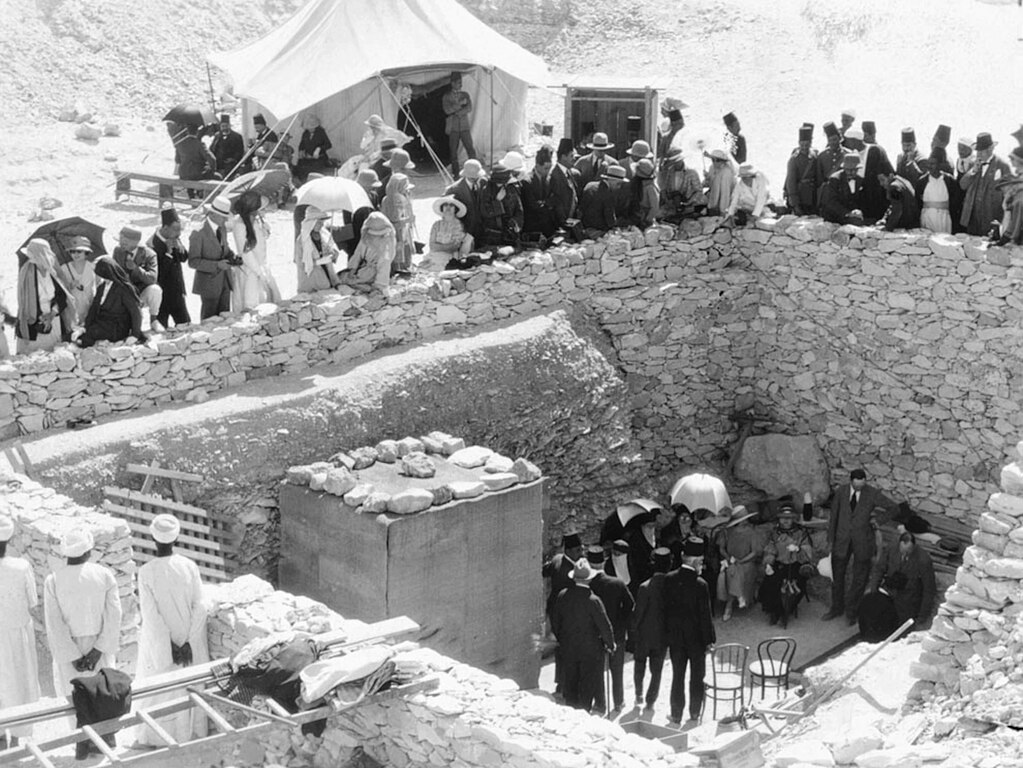 Maynard Owen Williams, Wikimedia Commons
Maynard Owen Williams, Wikimedia Commons
49. His Stuff Travelled The World
In the last century, dozens of exhibitions focusing on King Tut and his artifacts have been assembled and travelled all over the world. All of them have attracted record numbers of visitors to their host museums, and King Tut has become one of the hottest historical tickets on earth. But the pharaoh himself generally stays put.
 A. Parrot, CC BY-SA 4.0, Wikimedia Commons
A. Parrot, CC BY-SA 4.0, Wikimedia Commons
50. He Remains In His Tomb
As of 2007, King Tut’s mummy has been returned to his tomb in Luxor, Egypt, where he remains on display for tourists from all over the world to visit. The pharaoh who in life faced so much tragedy has, in a symbolic way, gotten the reincarnation he likely dreamed of on a scale he never could have imagined.


